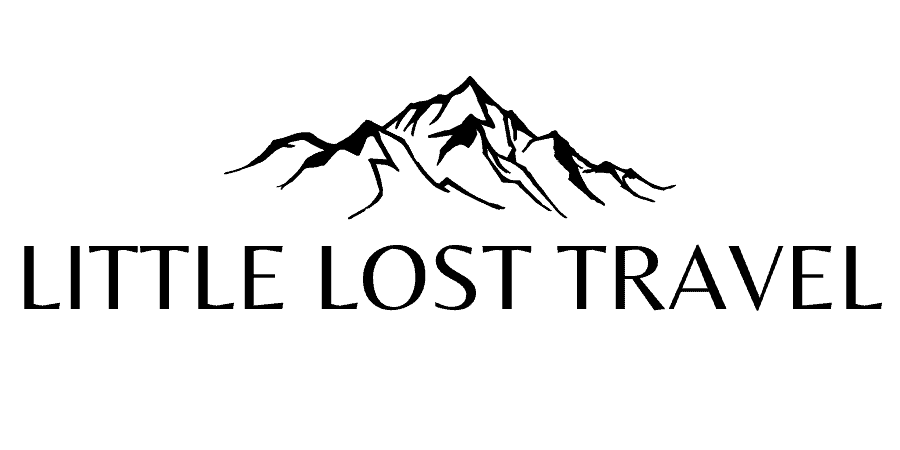

11 Stunning Cyprus Villages You Need to Visit
Posted by Francesca Brooking | Cyprus , Europe | 23

From narrow cobblestone streets to mountain views, ancient architecture and UNESCO World Heritage Sites, the villages in Cyprus are second to none with their wealth of culture and beauty.
Many of these villages are members of the island’s agritourism project, which works to support traditional artisanal and agricultural businesses.
These rural industries have been left almost unchanged for centuries, whether it’s wine, crop cultivation or handicrafts.
Away from the popular tourist hotspots and beach towns, these villages offer a glimpse into the real island, its rural beauty, its people and their famous hospitality.
So, without further ado, here are the stunning Cyprus villages you need to visit.
Map of the prettiest villages to visit in Cyprus
1. pedoulas village, nicosia.

One of the best Troodos villages to visit, picturesque P edoulas is located in the Nicosia district of Cyprus. High in the Troodos Mountains, it has a distinctly alpine feel to it.
Temperatures remain 10 degrees cooler than sea level, making it a popular holiday resort in the summer for those in need of a bit of cooling off.
The drive leading up towards it winds through surrounding pine forests and sometimes even low-lying clouds. You would be forgiven if you thought you were in Central Europe rather than an island in the Eastern Mediterranean.
Like many towns and villages in Cyprus, Pedoulas is home to a UNESCO World Heritage-listed church – the Church of Archangelos Michael.
Inside, you can find exquisite Byzantine and post-Byzantine frescoes from the 11th to the 19th Centuries.
2. Kalopanayiotis Village, Nicosia
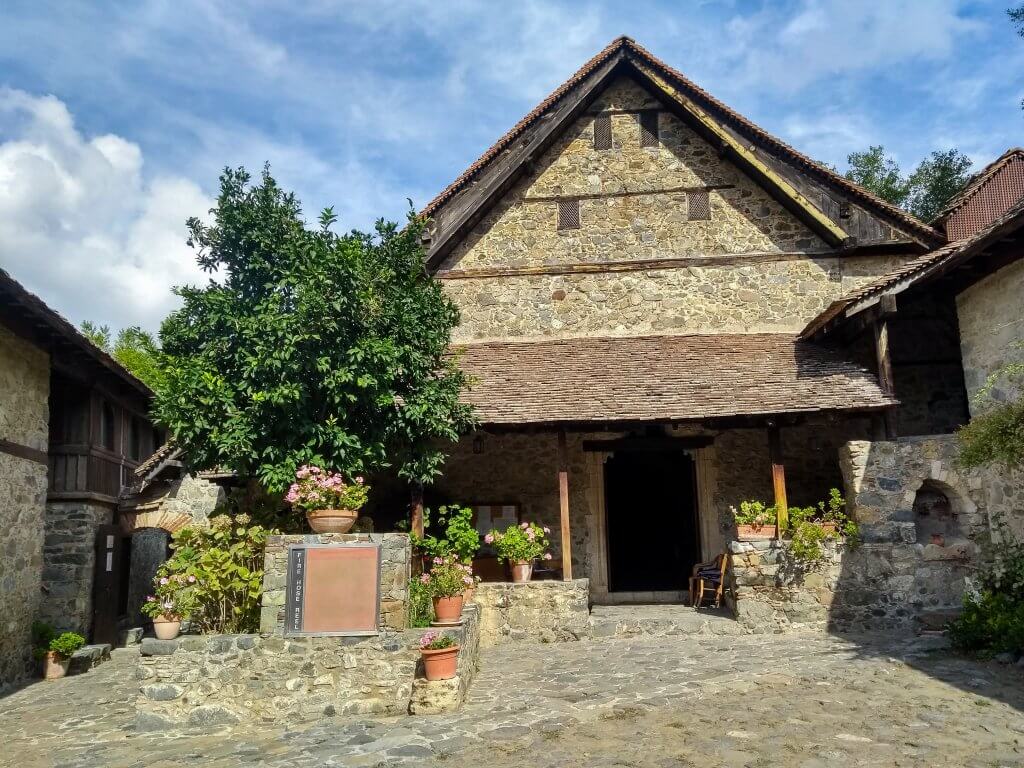
There’s nowhere better than Kalopanayiotis in the Troodos Mountains for spas, culture, and beauty . Temperatures are a little warmer here, and its steep, narrow cobblestone streets look down towards Marathasa Valley below.
The village is best explored on foot, but if you don’t fancy breaking a sweat up and down those slopes, you can park your car in the car park and take the short funicular , which only costs a euro each way.
It’s well worth doing this excursion because at the bottom of the hill is Casale Panayiotis , a spa, restaurant and villa complex rolled into one.
Also at the bottom are the famous sulphur springs. If you cross over it, you’ll come to the Agios Ioannis Monastery, a complex of three churches and, unsurprisingly, a UNESCO World Heritage Site. It’s one of my favourite hidden gems in Cyprus.
3. Omodos village, Limassol

Omodos is another Cypriot mountain village and a popular destination for those who like wine, artisan shops and history.
Located in the Limassol District of Cyprus, Omodos is a little busier than the other villages, but it certainly isn’t lacking in beauty. It’s one of the best villages to visit in Cyprus – it was certainly a top favourite for me!
The best way to see it in all its glory is to spend a leisurely morning strolling down its cobblestone streets.
You’ll notice tables brightly decorated with fresh bread, sweets, glassware and gorgeous homemade arts and crafts, including lacework and tablecloths.
Wander into the True Cross Monastery , one of the island’s oldest and most historic monasteries. It’s believed to be home to a piece of the True Cross.
If you start to get peckish, head to Katoi Tavern for the mother of all mezes which will keep you full for the rest of the day!
4. Arsos Village, Limassol

Another village in the Limassol District is Arsos. It’s the biggest wine-producing village in Cyprus and an important member of the island’s agritourism project.
This picturesque little village nestled in the hills provides a welcome retreat for hundreds of visitors as its climate remains cool and dry even in the height of summer.
If you’re a wine connoisseur, then make sure to put Arsos on your list.
This village is proud to be one of the best wine producers on the island, and you can spend a day exploring the local winerie s or even take it a step further and hike the popular Diarizos Valley wine route towards the region of Paphos.
Read more: What Does Sustainable Travel Mean and Why Does It Matter?
5. Tochni Village, Larnaca
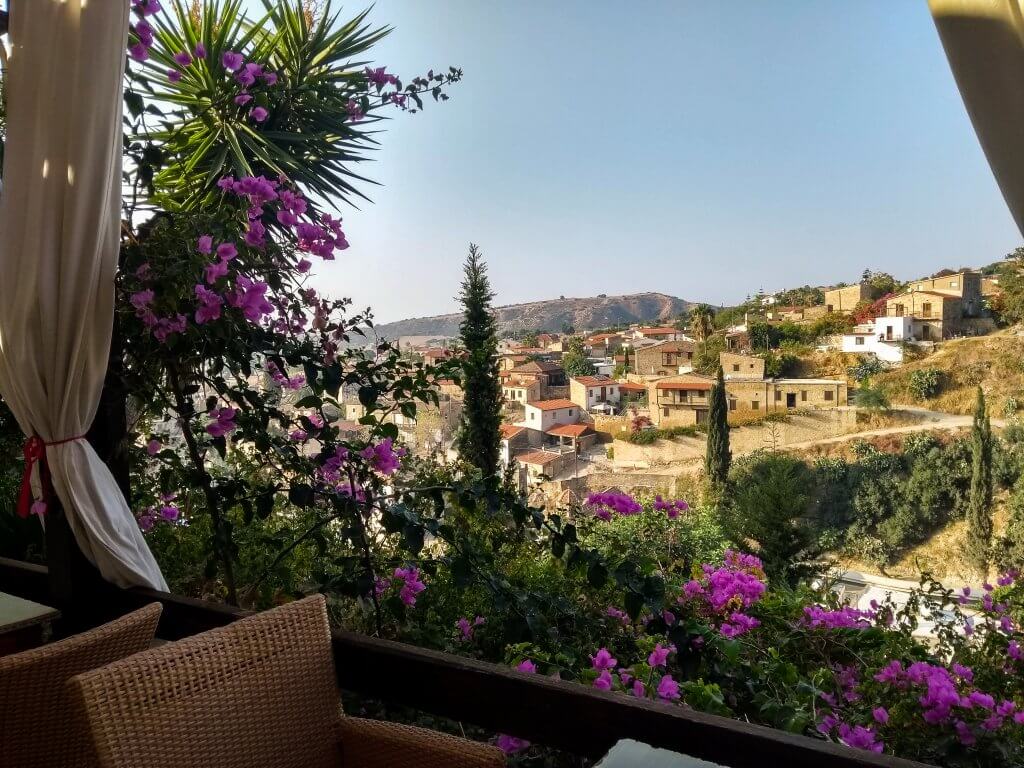
Each village, town and city in Cyprus prides itself on its unique and beautiful characteristics, none more so than Tochni Village.
One of the most beautiful villages in Cyprus , this stunning hidden gem in the Larnaca District is an important agritourism destination. Many of its buildings have been made out of the distinctive light-coloured ‘Tochni stone’ and renovated to provide modern comforts.
Tochni and its winding streets is the perfect village to get lost in (trust me, I did!). It’s best just to let it happen.
Take your time to enjoy the flowers cascading down from balconies, the friendly locals and the magnificent Church of Agiou Constantinou and Elenis.
It’s a fairly modern 19th-century building compared to some other churches on the island. If you get hungry, swing by Tochni Tavern for the best halloumi in Cyprus – in my opinion!
Wondering what to eat in Cyprus? Read my guide to traditional Cypriot dishes and where to try them.
6. Agros Village, Limassol

Agros is a stunning village located in the Troodos Mountains on the southwest of the island. It’s built amphitheatrically, which means it curves around the hillside, offering panoramic views of the surrounding forest.
The village still maintains its traditional roots, being a centre for agriculture, homemade marmalade, sweets and cured meats.
Agros is perhaps most well-known for its rose cultivation. Between April and May, the hillsides are painted pink with thousands of roses called the Rose of Damascus.
In May, the village throws its annual Rose Festival, culm inating with a harvest. You can learn all about what happens to the roses at Tsolakis Rose Factory and pick up some delicious-smelling souvenirs while you’re at it.
Discover how to save money when travelling to Europe with these budget tips!
7. Choirokoitia Village, Larnaca

Choirokoitia is a traditional village close to the main city of Larnaca. One of the old villages in Cyprus, it’s most famous for both its small, family-run halloumi producers and the nearby Neolithic settlement dating back to 7500-5200 BC.
Unsurprisingly, it’s a UNESCO World Heritage Site and ranks among the nine most ancient sites in the world.
Choirokoitia is a prime agritourism destination in Cyprus, and visitors are encouraged to explore its authentic village-focused attractions, including basket-making workshops and the Old Olive Mill, which showcases olive oil production methods and tools.
Read More: An Easy Slow Travel Guide to Mastering the Art of Experiencing More
Editor’s tip: See the best of the Troodos Mountains with this cultural tour from Paphos. Highlights include Aphrodite’s Rock, traditional mountain villages, Timios Stavros Monastery and the Millomeris Waterfalls. Finish off with a cheese and wine tasting!
8. Lefkara Village, Larnaca

The village of Lefkara is located in the mountainous region of Larnaca, at the foot of the Troodos Mountains. It’s most well-known for its Cypriot folk needlework and lace-making.
The craft dates back to at least the 14th century and has been given UNESCO World Heritage status. Legend has it that Leonardo da Vinci took one of the embroideries back with him as a gift for Milan Cathedral after visiting Cyprus in 1481.
The same legend also suggests that Lefkara lace inspired the tablecloth in his Last Supper painting!
Needlework is still a pastime among village women today.
Come here and wander the narrow and winding stone alleyways, see traditional needlework in action and have a look around the Folk Art Museum.
Cradled by mountains, it has a milder climate than its counterparts at sea level, making it a good choice if you want to escape the summer heat.
9. Platres, Limassol

One of the best mountain villages in Cyprus is Platres, otherwise known as Pano Platres. It’s a top wine-producing village surrounded by pine forests.
Although it’s a little on the small side, the village is particularly popular with visitors and saw several hotels crop up during the 20th Century.
Notable visitors to the village include King Farouk of Egypt and the Nobel Prize-winning poet Giorgos Seferis. A fun fact for literature lovers, the English author Daphne du Maurier was inspired to write Rebecca, her most famous novel in Platres.
Literary giants aside, Platres is a beautiful village in its own right and a worthy inclusion in your Cyprus itinerary.
Popular sites include the medieval Milia Bridge and Caledonia Waterfall, which tumbles from a height of twelve metres.
10. Doros Village, Limassol

If you’re seeking small Cyprus villages, look no further than Doros. Sometimes known as Thoros in English, it’s a quaint village tucked away in the foothills of Cyprus.
Hidden among almond trees and grapevines, it has a reputation on the island for producing excellent-quality wine, raisins and Commandaria – the oldest named wine in the world that’s still in production today.
As you explore the village, make sure you stop off at Karseras Winery .
Here you can taste this prestigious wine for free, learn about its fascinating history, and how it’s made and even take a few bottles home with you. Trust me, you’re going to want to!
Editor’s tip: This popular wine tour takes you to the very best villages in the Troodos Mountains and offers the chance to try some seriously good award-winning wines!
11. Lofou, Limassol

Sitting atop rolling hills, Lofou is another Cyprus village with an ancient past. It’s thought that people have inhabited the area since the early to middle Bronze Age.
The village today is a pretty labyrinth of winding cobblestone streets and traditional stone cottages topped with bright red roofs. It’s been referred to as ‘Lofou’ since the Byzantine era.
The best thing to do here is take yourself for a wander, stopping by the Folk Art Museum and the Olive Press Museum. If you get peckish, I recommend lunch at Kamares Taverna.
For a nature fix, follow the Lofou Walking Trail which is a one-kilometre downhill footpath to the traditional faucet of Elitji which was built as a water source in 1842.
If you happen to time your visit to the end of September, you’ll be able to join Lofou’s harvest celebration, Grape Fest. The one-day festival involves wine and grape juice tasting alongside folkloric performances.
How to visit these Cyprus villages
Most of these rural villages are only accessible by driving. Public transport in Cyprus is limited to buses which are infrequent and unreliable in rural areas.
Renting a car will give you the most freedom but if you don’t drive, you can still see some of these villages on day tours.
Here are the tours I recommend:
- From Paphos: Troodos Mountains & Villages Guided Day Trip
- From Paphos: Troodos, Paphos Forest, Kykkos, and Omodos Tour
- Cyprus: Troodos Mountain Wine Tour with a Local
- From Paphos: Troodos-Venetian Bridge-Millomeris Waterfall
- Paphos: Choirokitia & Famagusta Guided Tour with Transfers
Editor’s tip: If you’re wondering where to stay, Paphos is a great base from which to explore Cyprus.
Final thoughts on villages to visit in Cyprus
I hope you enjoyed my guide to the best villages to visit in Cyprus. If you’re planning a trip, check out my Cyprus travel guide below, which tells you how to spend three days or longer on the island.
Cyprus has a wealth of amazing things to do and see, and its villages are a huge part of its cultural identity. I hope this roundup inspires you to visit some of these beautiful villages in Cyprus.
Inspired? Read more Cyprus travel guides below!
- The Best Cyprus Itinerary for a Long Weekend (Or More!)
- 11 Hidden Gems in Cyprus You Need to Discover
- Traditional Cypriot Food and Drink You Need to Try

Pin me for later!
This post may contain affiliate / compensated links. As an Amazon Associate, I also earn from qualifying purchases. For full information, please see my disclaimer here .
About The Author
Francesca brooking.
Francesca Brooking is the Founder of Little Lost Travel. A travel expert with a passion for the planet, Francesca is on a mission to help you travel well. From Costa Rica to Jordan, she's travelled all over the world. When she's not off on an adventure, she's reviewing sustainable travel products and writing travel guides.
23 Comments
What charming little villages. I could see myself happily spending a vacation making my way around all of them taking tons of photos. Gorgeous views
Thank you! That’s the best way to do it for sure!
These photos are breathtaking, wow.
What a pleasure to have this tour through these charming villages. I can imagine how wonderful it would be to visit from your words and photos.
Thank you! It’s a lovely place.
Love your photos! Cyprus is on my list!
Cyprus is stunning!
A picturesque array of pretty villages, each with their own sights and sounds; absolutely stunning. Would love to spend a whole season here, ambling through the idyllic villages, meeting the people and eating the local food!
Thank you. That’s definitely the perfect way to have an authentic experience in Cyprus!
I want to visit them all. I’ve been to Paphos so can skip that one but they are all so pretty.
Thank you, they’re so lovely and each one has its own unique charm!
What a diverse set of villages! One after the other, I was thinking to myself “ok, this one is the one for me!!” In the end I think I’ll have to visit them all 🙂
Haha it’s definitely worth it! Each one is special in their own way.
I love visiting these kind of smaller towns when I travel. Just because I’m a foodie, I want to visit that taverna with the delicious food; Cypriot food is awesome!
It really is and you get so much food!
These Cyprus villages are beautiful! There’s so much natural elements and greenery–I can just imagine how beautiful it is to take a stroll there.
They’re so beautiful and each one has its own character too!
What a beautiful collection Francesca. I love driving around finding little gems like this. I’d be off to Tochni to try that halloumi.
Thank you! Definitely a good choice haha.
It’s a shame you haven’t included LEFKARA, known for its Lefkaritiko embroidery. As legend has it, in 1481 Leonardo da Vinci visited Cyprus and purchased Lefkara lace for the High Altar of the Cathedral of Milan. Lefkara is perched in the mountains, adorned in stone-built houses, romantic alleyways and rich in history. In fact, during the Venetian occupation, women from the Larnaca plain district, would seek the cooler summer days at Lefekara. It is said that the making of this exquisite embroidery originated from Venice, and to this day it has become a trademark for Lefkara, known all over the world!!!!
Hi Mary, thanks for the tip! I’ve updated my article with your suggestion. 🙂
Hey, You missed Kakopetria
Leave a reply Cancel reply
Your email address will not be published. Required fields are marked *
Save my name, email, and website in this browser for the next time I comment.

Hello, I’m Francesca
My mission is to show you why sustainable travel is empowering, fulfilling and affordable.
Little Lost Travel is your complete guide to nature-based and sustainable travel. Here, you can discover the best ecolodges in the world, sustainable destination guides and so much more!
Memberships
Stay connected, get a free guide to sustainable travel.
Become part of the Little Lost Travel community and get:
- a FREE quick guide to sustainable travel
- Monthly newsletter featuring the latest blog posts
No spam, just awesome travel content.
Read our Privacy Policy here.
Thank you! Check your inbox to confirm your subscription.
Pin it on pinterest.
Last Updated on 06/03/2024
- Discover Rural Larnaka: Top 5 Villages

- October 7, 2021
My father is from a Larnaka region village called Kelia (close to the town). As such, I spend my trips to the island visiting his village and also exploring villages of Larnaka region further afield. I absolutely love the authentic way of life that these communities still cherish, and the pride the locals have for their traditions and heritage.
Aside from Kelia, my other top five village outings in Larnaka region is hard to narrow-down, so I have chosen the ones that I think offer the broadest appeal for all travellers, but if you have more time on your hands to explore some of the others then you certainly won’t be disappointed!
Lefkara village in Larnaka’s Orini (mountainous) areas is possibly the most famous village on the island! Visitors love this charming hillside retreat with narrow lanes and the opportunity to watch the local women make their hand-embroidered lace pieces (known as ‘Lefkaritika’). The village is equally known for its gorgeous filigree silver. I always pick up a pair of delicate cobweb effect earrings when visiting! You can learn about both at the Lefkara Handicraft Centre. The Ktima Defarmou Winery in Lefkara Valley is also worth a visit and you will be warmly welcomed to sample the vintages and learn more about the traditional winemaking process.

Lefkara’s neighbour Kato Drys is equally picturesque and is one of the nine ‘Rural Larnaka Honey Villages’. Visit the unusual and unique Bee & Embroidery Museum ; the traditional ‘Local Agricultural Museum of Kato Drys’, or enjoy some more wine tasting at Ktima Christoudia where you will be guided on the traditions of wine making and can sample the delicious local wines amidst stunning rolling views.
In rural Skarinou village, the big-eyed donkeys await you at the Golden Donkeys Farm. The farm is a sanctuary for donkeys of all ages, and again, you can enjoy feeding the animals, taking a ride, or relaxing in the grounds. Also in Skarinou is Agroktima Agios Georgios – another donkey and animal park with a large playground that holds various family events.

Tochni is a village that is rich in history and traditional architecture. I love the stone-built houses that are built with stone from the nearby quarry. This is a great village for lovers of the outdoors as there is a 3km nature trail that winds through beautiful countryside that is also perfect for cycling. One of the Larnaka Tourism Board’s thematic cycling routes passes through Tochni too. Look out for the Saints Constantine and Helena Church that sits on the bridge above Arkatzin river (the only church on a bridge on the island).

Agios Theodoros
The stunning valley where Agios Theodoros is nestled is one of the prettiest areas of the region with the village built along two banks of the Pentaschoinos river. This is another gem with traditional architecture, from the houses to the churches (including Agioi Anargiroi and Panagia Astathkiotissa chapels). Don’t forget to add the ‘Old Olive Mill’ and the ‘Orchard of the Village’ picnic site to your list of must-sees! As both a mountain and coastal village, the beaches here are also picture-perfect.

Delikipos is one of the smallest, ‘cutest’ and most beautiful villages I have ever visited (its population is tiny!), and it really is a green oasis with its nature trail that passes by a pretty waterfall that joins the river that flows under a double stone bridge. The village also has groves of ancient olive trees and is a fragrant and colourful retreat when in full bloom. We always take a picnic and spend time at the picnic park and the village playground, simply taking in the tranquility!

LIMASSOL TRAVEL GUIDES

Limassol’s Luscious Winemaking Tradition

Best Beaches In Limassol

Neighborhoods in Limassol

48 Hours in Limassol
Comments are closed for this article!
LATEST POSTS

Diving in Famagusta Region (Ammochostos)

Family Fun in Paphos

Lefkaritiko Lace: Stitches with History
- Culture & Religion
- Eat and Drink
- Sightseeing
Never miss an update!
Stay up to date with our blog posts & announcements by subscribing to our Newsletter.

16 Top-Rated Attractions & Things to Do in Larnaca
Written by Jess Lee Updated Dec 26, 2023 We may earn a commission from affiliate links ( )
Larnaca (also called Larnaka) is one of the premier seaside resorts in Cyprus . For most visitors, the main tourist attractions here all revolve around sun, sea, and sand, with the beaches of both the town itself and farther east down the coast surrounding Agia Napa, within easy reach.
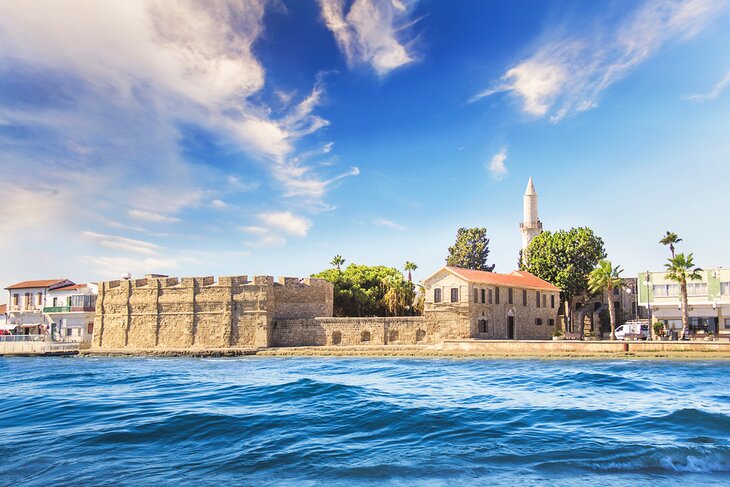
For sightseeing off the sand, Larnaca's beautiful Agios Lazaros (Church of St. Lazarus) and an atmospheric and crumbling Turkish quarter, where Larnaca's famous ceramic artisans have set up shop, are the main focus. There are major attractions below the sea surface here, too, with diving the Zenobia wreck one of the main things to do.
Larnaca is an easygoing place with a distinctive, laid-back vibe that sets it apart from the more bustling centers of Paphos and Limassol. Better yet, it's also in a prime position for forays inland to the quaint villages and places to visit of the Maheras forest region.
Begin your exploring by using this list of the top attractions and things to do in Larnaca.
1. Soak Up the Sun on the Agia Napa Bay Beaches
2. admire the interior of the agios lazaros, 3. dive the zenobia wreck, 4. spend an easygoing day on larnaca's beaches, 5. snorkel or dive the museum of underwater sculpture (musan), 6. visit larnaca fort, 7. shop for ceramics in skala, 8. day trip to stavrovouni monastery, 9. explore the lanes of lefkara, 10. visit the hala sultan tekke, 11. admire the architecture of agia napa monastery, 12. hike the trails of cape greco, 13. tour the exhibits inside pierides archaeological museum, 14. stop at kamares aqueduct, 15. delve into history at larnaca archaeological museum, 16. head to the beach resort of protaras, where to stay in larnaca for sightseeing, map of attractions & things to do in larnaca.
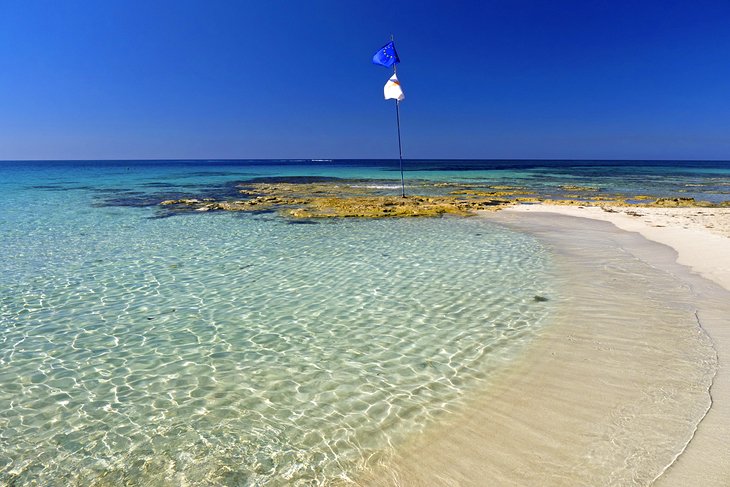
Cyprus' most famous beaches are all in the southeast of the island around the town of Agia Napa, 45 kilometers east of Larnaka.
Top of the tourist attractions is Nissi Beach, a long stretch of perfectly white sand with an island rock outcrop just offshore that's on the western side of Agia Napa town. This is also a great destination for capturing pictures of Cyprus . Be aware that Nissi's beauty means that it can get heavily crowded in summer.
If you're trying to escape the crowds, head to Kermia Beach (two kilometers east of Agia Napa), which is smaller but just as pretty, or head to Konnos Beach (two kilometers east of Kermia Beach), which is a great choice for families with kids who want to get into the water, as the sea here is calmer than elsewhere.
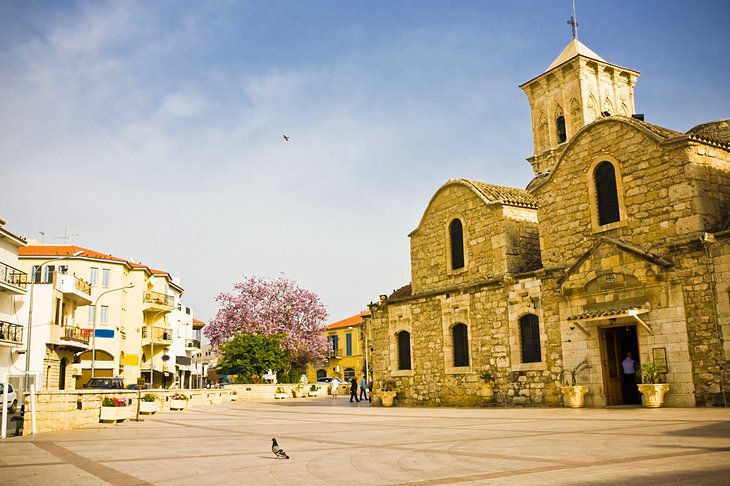
According to local lore, after Lazarus rose from the dead, he lived here in Larnaca (then known as Kition) for another 30 years and was ordained as Bishop of Kition. When he finally died – this time for good – he was buried here, where the stately Agios Lazaros (Church of St. Lazarus) now stands.
The church was built in the 9th century by Emperor Leo VI and was faithfully restored in the 17th century.
The church has four domes over the nave, and the roof is supported on four sets of double columns. The pulpit is uniquely placed in one of these columns and is lavishly decorated in gilt. In another column is a silver icon from 1659, with a picture of St. Lazarus.
Check out the incredibly ornate iconostasis for an excellent example of Baroque woodcarving.
Beside the iconostasis, a staircase leads down into the Tomb of Lazarus (though remains found there in 890 CE – which may, or may not be of Lazarus himself – were moved to Constantinople and later to Marseille).
The church is also home to impressive paintings of the Virgin and Child and St. George and the Dragon.
Across the courtyard from the church is the Byzantine Museum which holds a collection of religious icons and relics.
Address: Agiou Lazarou (Larnaca Main Square)
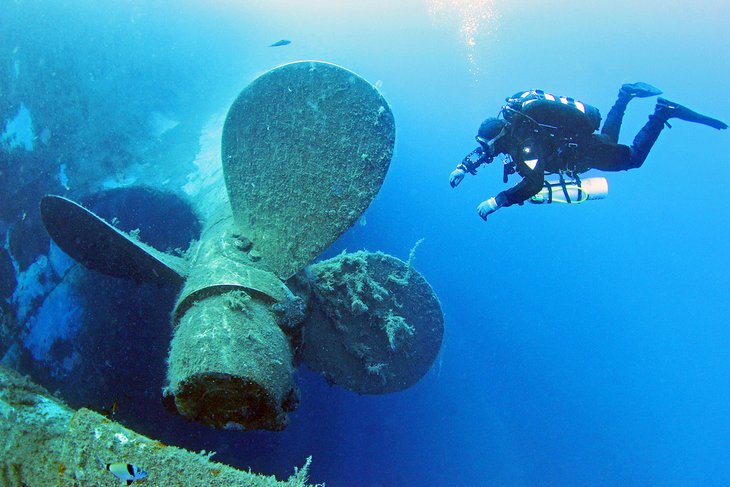
The Zenobia wreck is Cyprus' major tourist attraction for scuba divers. In 1980, this Swedish cargo ship capsized just outside Larnaca Bay. The ship, with its cargo of tractor-trailers (which is said to have been a cargo loss of around US$200 million) has since become one of the world's top wreck dive sites .
The wreck provides dive explorations for all levels of divers with newly PADI qualified divers able to dive down to the starboard side of the ship, while more experienced divers can dive lower, down to the car decks, and enter the innards of the ship.
All dive companies in town offer Zenobia trips, as well as dive companies in Paphos and other Cypriot resort towns.
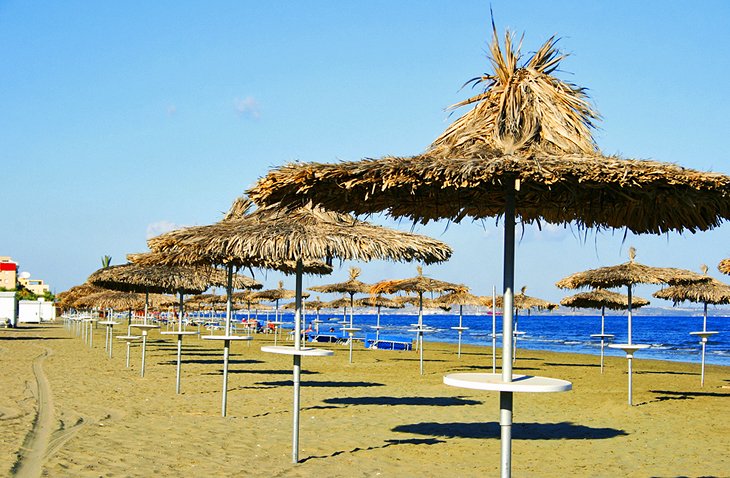
Larnaca's beaches are packed from about May to September when locals and tourists alike flock to the water to cool off.
Finikoudes Beach is strung out along the main promenade and although conveniently located, is rather uninspiring and is a bit of a sardine-squeeze in peak holiday season.
Mackenzie Beach (two kilometers south from the center) is much nicer and generally has more room to throw down your towel.
If you've got your own transport though, it's much better to head slightly south to Cape Kiti Beach (15 kilometers south of Larnaca) or Perivolia Beach (one kilometer south of Cape Kiti Beach), which rarely attract more than a handful of sunbathers and are gorgeously situated in secluded coves.
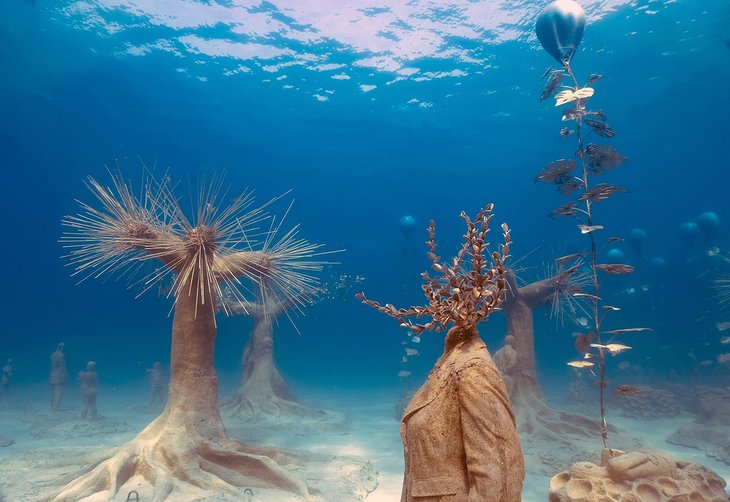
MUSAN (Museum of Underwater Sculpture Agia Napa) is one of the newest tourist attractions in Cyprus . This unique project – the first in the world – combines an underwater sculpture park and reef reforestation project stretching across 175 meters in Agia Napa's Marine Protected Zone.
The 93 seabed sculptures have been designed by eco-artist Jason deCaires Taylor as an underwater forest to attract marine life while also creating a fairy-tale underwater world for both snorkelers and divers to explore.
The seabed here is between eight and 10 meters in depth and, as many of the sculptures rise to eight meters high, snorkelers can enjoy good views from the surface. But to get the full experience and explore the depths of the sculpture park, you'll have to be a qualified diver.
MUSAN is based on Pernera Beach, two kilometers west of central Agia Napa and 43 kilometers east from Larnaca.
Official site: http://www.musan.com.cy
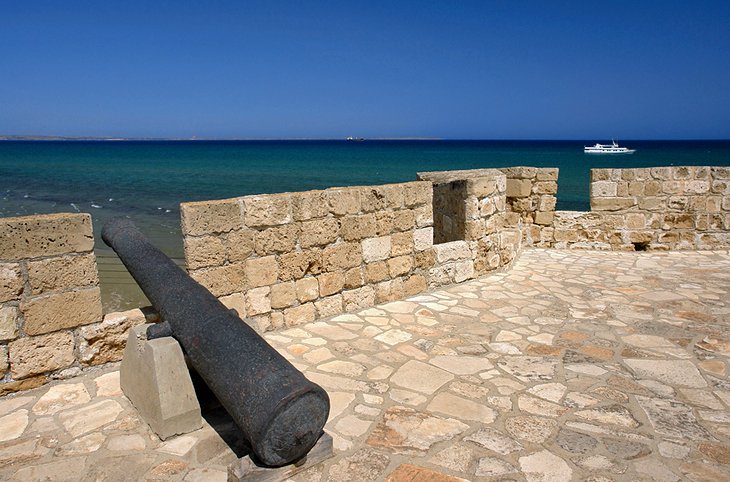
Right on the edge of Larnaca's seaside promenade, this Ottoman-era fort, built in 1625, was used as the Ottoman's main line of defense for the city. It stands on the site of a much earlier medieval fort of which nothing remains. During the British colonial period, the fort was turned into a prison.
Today, it's home to Larnaca's small Medieval Museum and displays a small collection of weaponry as well as some great black-and-white photographs of the local area.
Climbing up onto the ramparts offers good views across the Mediterranean Sea.
Across the road is Larnaca's Grand Mosque , which was once the Holy Cross Latin Church and dates from the 16th century. It's worth taking a peek inside the compound to check out the small cemetery with its old intricately-embellished tombstones.
Address: Leoforos Athinon Promenade
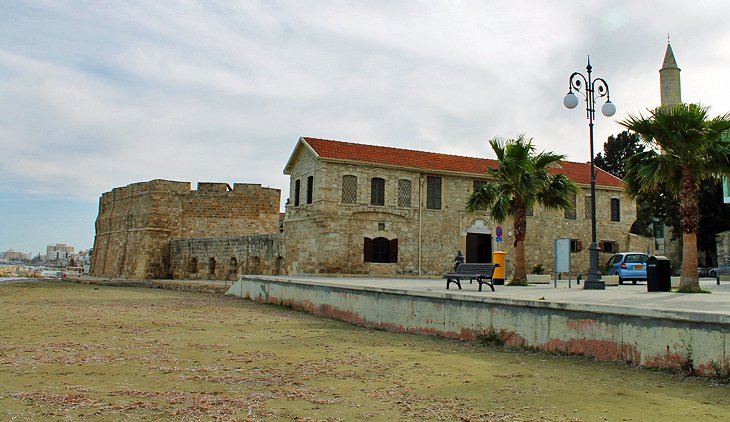
Larnaca's most interesting district to explore, the old Turkish Quarter (also called Skala) begins at Larnaca Fort and rambles south in a jumble of narrow lanes.
After Larnaca's Turkish population was forced to leave for the north during the population transfers that followed the island's division, the district of Skala was ignored and slid into dilapidation for decades.
In recent years though, this neighborhood has undergone a burst of revival as Larnaca's artisan community have begun moving their ceramic workshops here.
As the district has been ignored by modern developers, it retains much of its traditional character, with whitewashed cottages, nattily decorated with colorful window frames.
Come here to see a quaint old-fashioned architecture style that is fast disappearing in Cyprus' seaside resorts and to browse the pottery shops that are popping up within the back lanes.
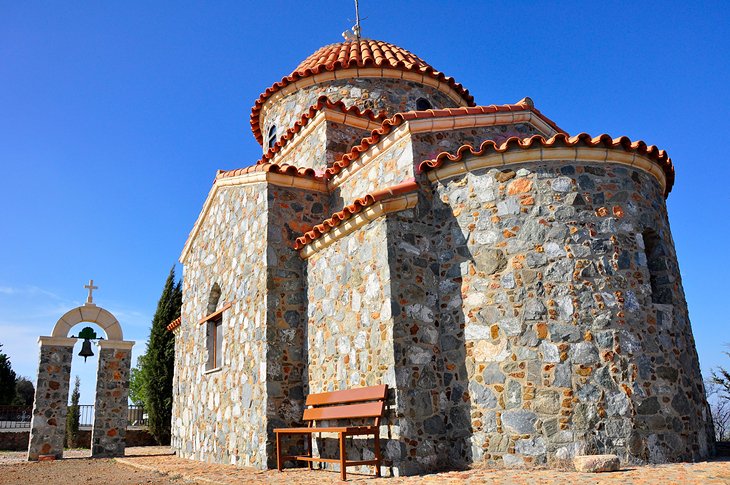
About 40 kilometers west of Larnaca, atop a jagged clifftop, Stavrovouni Monastery sits in splendid isolation commanding superb panoramic views across the surrounding countryside. This area has long played a role in local religious rites. During Cyprus' period under Greco-Roman control, the summit here held a temple honoring the Goddess Aphrodite.
In 327 CE, Empress Helena (mother to Emperor Constantine) sponsored the building of this monastery to take the place of the temple and left a fragment of the Holy Cross in the monastery monks' possession.
At the time, Cyprus was suffering under an infestation of poisonous snakes, and local Christians believed that the holy cross installed here under the monks' care brought an end to the snake plague.
During the Arab attacks of the 15th century, the original monastery was burnt to the ground, and the current building dates from the 19th century.
Be aware that females are not allowed into the actual monastery – although they can view the grounds, which have stupendous views, and visit All Saints Church just outside the compound. Male visitors, though, are free to wander through the monastery and explore the icon laden interiors.
You will need your own transport to get here.
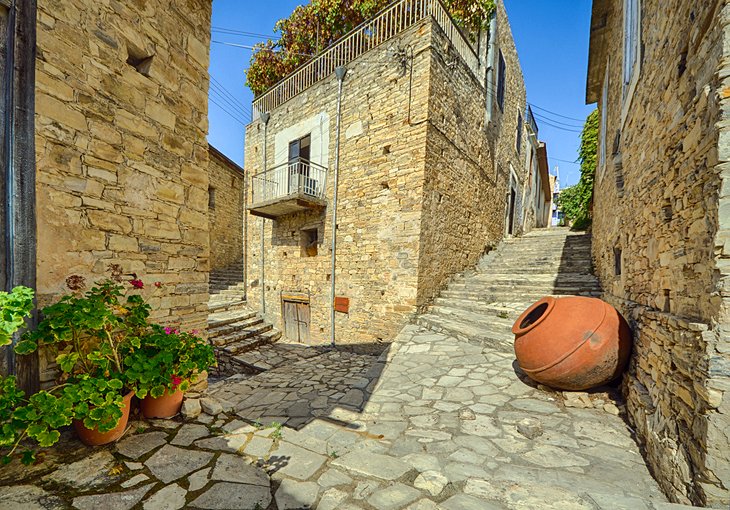
The villages surrounding Larnaca are some of the best places to visit if you want to get a feel for traditional Cypriot life.
Famous for its lace production, the village of Lefkara, west of Larnaca, is a delightful place to explore, full of wonderfully preserved mansion architecture, quaint cafés, and a bundle of lace shops where local women sit in the sun outside creating new lace pieces for sale.
Lefkara lace gets its fame from the local story that Leonardo da Vinci bought a piece of lace here in 1481 to be used as an altar cloth in Milan's cathedral.
When you've finished shopping, the winding alleys lead you to Lefkara Local Museum which contains dioramas of traditional local life and is brimming with information on the village's history.
Afterwards, stroll on to the Church of Archangelos Michael , which holds some important 12th-century icon paintings.
The village lies about 38 kilometers southwest of Larnaca and is difficult to access by public transport, so it's best to hire a car, or take a taxi, here.
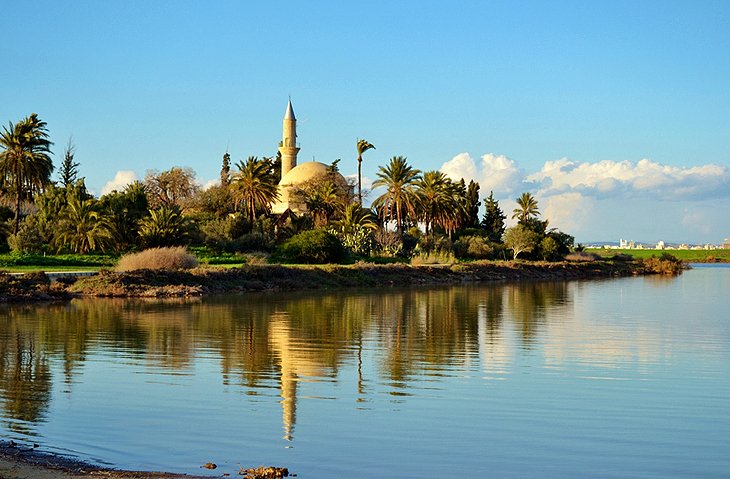
Number one on the things to do list for those seeking some nature just outside Larnaca city is the serenely beautiful Hala Sultan Tekke.
This mosque and shrine sits on the western side of Larnaca's Salt Lake, three kilometers west of central Larnaca.
An important place of pilgrimage for Muslims, this mosque honors the prophet Muhammad's wet-nurse, Umm Haram, who is said to have died at this site after falling from her donkey, and a shrine was dedicated over her tomb in 645 CE.
The present mosque building was built by the Ottomans and dates to 1816.
Larnaca's Salt Lake is a nature reserve and in spring, large flocks of flamingos and ducks can be easily seen.
During summer, the waters evaporate completely, leaving a crusty white layer of shimmering salt in their place.
The area is ringed by a walking trail, which also leads to the Hala Sultan Tekke and makes a lovely afternoon stroll.
Due to Larnaca's rather chaotic public transport system, it's easiest to get to the lake and the mosque by your own transport.
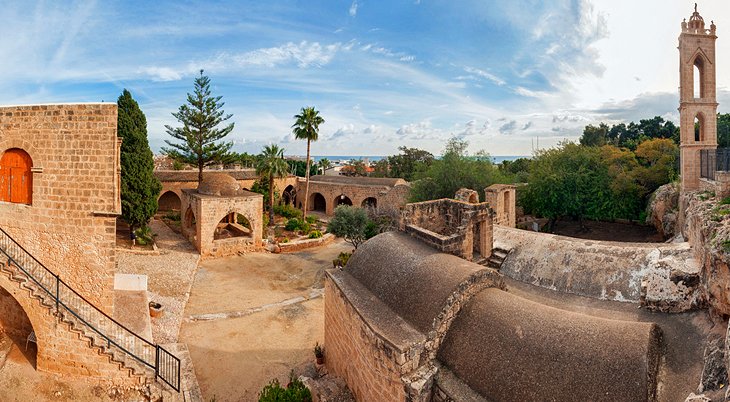
Just 45 kilometers east of Larnaca, Agia Napa is home to this famous Venetian-built monastery that sits right in the center of town. The monastery was one of the final buildings erected during the island's Venetian era.
It sits on top of a cave where an icon of the Virgin Mary was stored for safety while the destruction of the Byzantine Iconoclasm raged across the island.
The monastery was founded in the 16th century by a Venetian nobleman's daughter, who came here looking for a secluded retreat after her father refused to let her marry a commoner. She built two churches, one Catholic and one Orthodox, both of which are now under the same roof.
The fountain house in the middle of the courtyard was built as her tomb and bears pictures of her parents, herself, and a lion chasing a deer.
The church survived the Ottoman invasion unscathed and was still in use during that period, although it was abandoned in the 18th century and fell into disrepair.
By the south wall is a gateway with a pool overlooked by a huge sycamore fig tree which is said to be 600 years old.
There are hourly buses to Agia Napa from Larnaka, which drop you right beside the monastery.
Address: Plateia Seferi (Agia Napa Main Square), Agia Napa
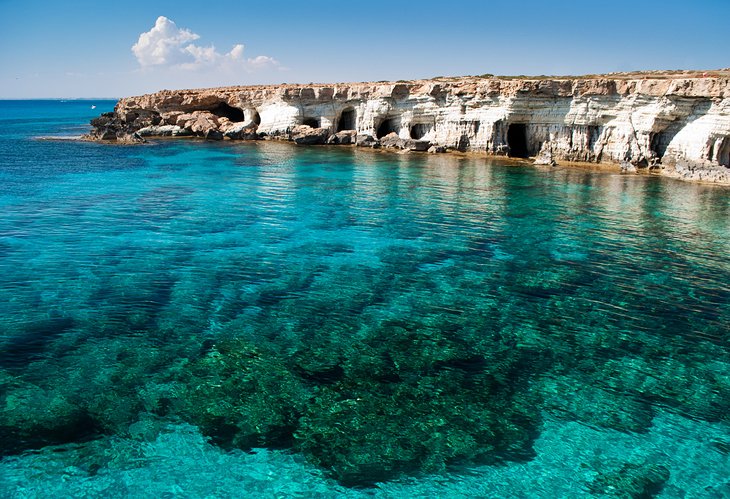
For a hike or stroll with stunning coastal panoramas head to Cape Greco, 60 kilometers east of Larnaca. This national park, set between the towns of Agia Napa and Protaras is the island's most southerly point.
The easy trails here (perfect for families wanting a nature walk, as well as more experienced trekkers) loop across the high cliffs with views sweeping across the Mediterranean beyond.
There are plenty of benches perched along the cliff edge if you want to linger and enjoy the seascape from above.
For the more active, staircases cut into the cliff allow access to some of the sea caves below.
Konnos Beach lies at the Protaras end of Cape Greco, so pack your swimsuit and cool off with a dip at the end of your hike.
As well as the coastal path, wildflower enthusiasts may want to explore the various other hiking trails that branch off from the main path, where a multitude of wild orchids grow in the spring.
There are regular buses between central Agia Napa and Protaras that can drop you right in front of the park's entrance.
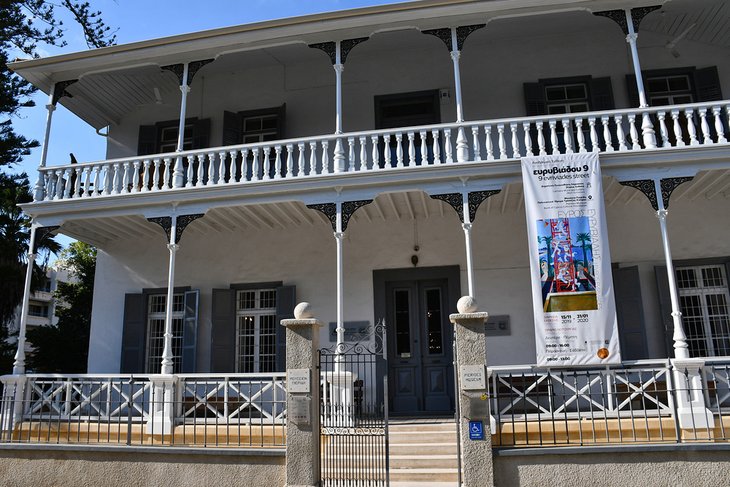
This fantastic museum, set in a restored 18th-century mansion, just behind Larnaca's seafront, houses a remarkable private exhibition of Cypriot antiquities, originally collected by Demetrios Pierides (1811-1895), a Cypriot scholar and archaeologist, and further enriched by members of his family.
The museum was founded in 1839 and holds 2,500 exhibits, which range from the Neolithic to the medieval period.
In Room One, Neolithic pottery and various representations of goddesses, along with bowls used in rituals can be seen.
Move on to Room Two for more pottery with pictures of birds and fish, as well as figurines used in religious rites.
Room Three includes jugs from the site at Marion, alabaster vases, and a mask on the wall, and Room Four has pottery from the medieval period and a collection of glass, as well as some jewelry.
Address: 4 Zinonos Kitieos Street, Larnaca
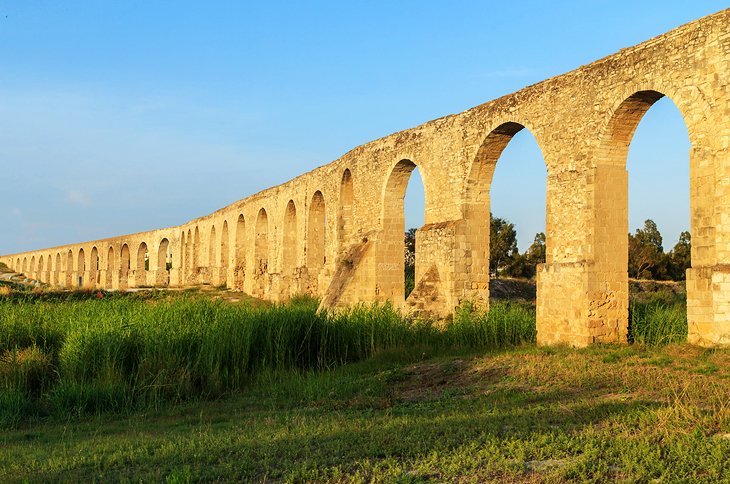
Built in 1746, this impressive aqueduct on the outskirts of town provided Larnaca's water supply until the 1930s.
Once part of a complicated water engineering system that used a combination of tunnels as well to deliver water into the town, it was constructed under orders of the local Ottoman governor and styled on typical Roman era aqueducts.
Today, the still sturdy 33 arches rambling across the green fields are an impressive sight.
Come during the evening when the arches are lit up, or during the day, when sheep are grazed in the fields between the arches.
You can get to the arches by hopping on any city bus that's heading in the direction of the K Cineplex.
Address: Old Larnaca-Limassol Road, Larnaca
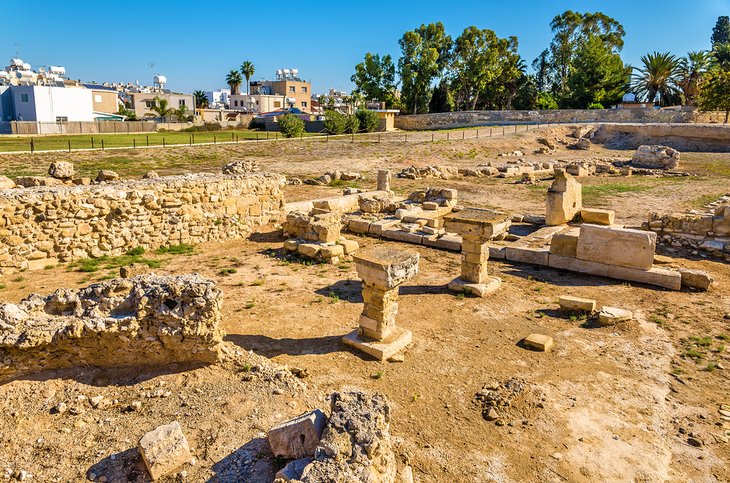
Larnaca's Archaeological Museum is home to a collection of finds from across the surrounding region dating from the Neolithic Age to the Roman period.
The first room displays sculptures, mainly female torsos and terracotta figures, while the next room houses the pottery collection from excavations at Kition (Larnaca's ancient name) and Livadia, a village just east of Larnaca, with Mycenaean vases and a variety of ornaments in bronze, clay, and glass.
There are also some Neolithic artifacts from Choirokoitia and some glass from the Roman era.
Although the collection can be slightly haphazard and not well-labeled, it's worth stopping off here, especially to view the terracotta figures, which are supremely beautiful.
A short stroll from the museum is the archaeological site of Ancient Kition where much of the collection hails from. Although there's not much to see, check out the remnants of the Cyclopaean walls and the ruins of temples , which date back to the 13th century BCE.
Address: Plateia Kalogreon Street
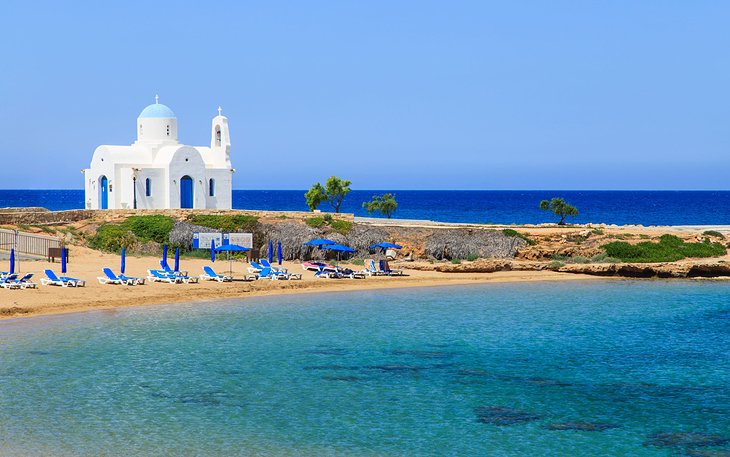
Protaras is one of Cyprus' favorite seaside resorts for families on vacation. The beaches here – particularly Fig Tree Bay – have fine white sand and incredibly clear and calm waters that are great for kids to splash about in safely.
The town itself has an easygoing vibe far from the hustle and bustle of bigger resorts, and most people who holiday here come strictly for lazy beach days.
The small church of Agios Elias is on a peak beside the main road into town, and if you do feel like a short climb, the summit offers great views along the entire coast.
The bus ride to Protaras from Agia Napa only takes 20 minutes, so you can easily get a bus from Larnaca to Agia Napa and then onward to Protaras, and return the same way, in a day.
Protaras is located about 70 kilometers east of Larnaca.
You'll find hotels in Larnaca in and around the town center, as well as along the beaches stretching east from the town.
Luxury Hotels:
- The Golden Bay Beach Hotel is right on the beach about 10 kilometers from Laranca's downtown. It offers a range of rooms and suites, including some with private Jacuzzis. All rooms have balconies with either city, pool, or sea views. You can dine at the on-site restaurants. There are indoor and outdoor swimming pools, a spa, a kids' club, and seasonal entertainment among other amenities.
- The Ciao Stelio Deluxe Hotel is a boutique property by the blue flag-rated Mackenzie Beach, about two kilometers from the town center. The hotel has good views of the Mediterranean Sea but is not directly on the beach — you'll need to cross the road.
- In a great location for exploring Larnaca on foot, the Hotel Indigo Larnaca is a 4-star hotel with contemporary rooms. An adults-only property, it has a rooftop pool, fitness center, and a restaurant that serves a complimentary breakfast.
Mid-Range Hotels:
- On the beach at the edge of town, Sun Hall Hotel offers easy access to the city center and the sea. The rooms are clean with an airy, modern vibe. Amenities include a restaurant, spa, outdoor pool, and bike rentals.
- In central Larnaca, Rise Street Art Hotel is a unique mid-range choice. The hotel is decorated with street art and has a fun vibe throughout. It is just a five-minute walk from the famed Finkoudes area.
- Renovated in 2020, Sveltos Hotel has a modern vibe and is set near the bay east of the town center. The hotel has lots of family-friendly amenities. There is a kids' club, indoor and outdoor play areas, and a kiddie pool.
Budget Hotels:
- The Antonis G Hotel Apartment is a good budget choice. It offers self-catering apartment rentals and is family-run. On-site amenities include a pool, restaurant, pool tables, bike rentals, and often live music on weekends. The location is central for exploring. Car rentals can also be arranged here.
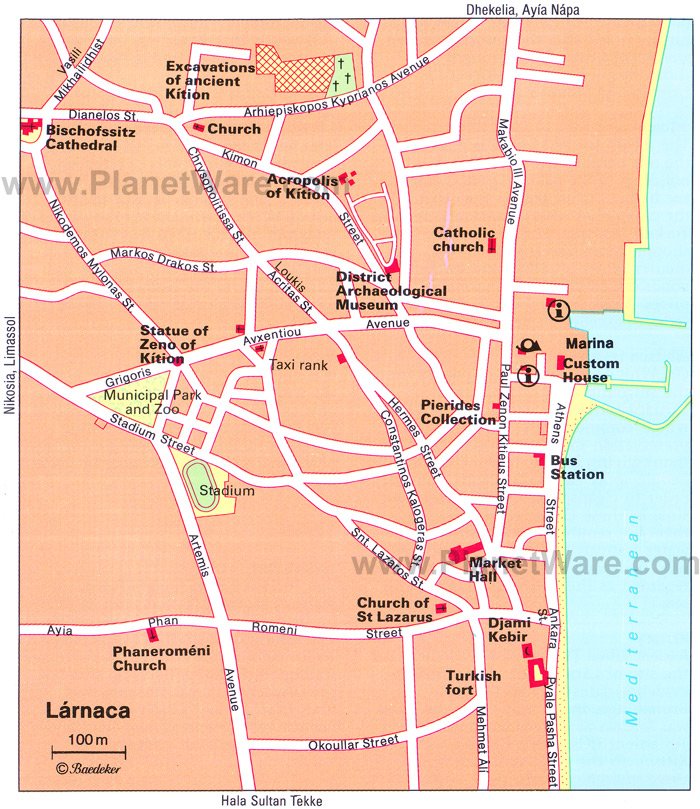
More on Cyprus
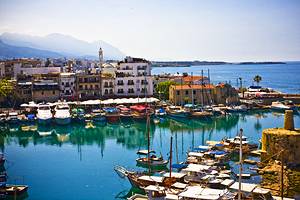
- Limassol Playgrounds
- Limassol Molos
- Limassol Wine Festival
- Limassol Things to Do
- Must-Visit Limassol Historical Sites
- Armou, Paphos
- Paphos Sites
- Best Paphos Hotels for a Memorable Vacation
- Troodos Mountains: Things To Do
- Agros Rose Festival – Cyprus Annual Event
- Mesa Potamos: Waterfalls, St. John Monastery
- Casale Panayiotis – Kalopanayiotis
- Top 10 Cyprus Winter Cozy Places
- Sparti Rope Park
- Manolia City Residences
- Best Nicosia Playgrounds
- Golden Donkeys Farm, Skarinou
- Camel Park, Mazotos
- Vavla, Larnaca
- Cyprus Vavla Rustic Retreat: A Traveller’s Review
10 Charming Cyprus Villages
- Cyprus Winter Activities
- Cyprus Animal Farm Parks
- Cyprus wineries worth visiting
- Cape Greco Viewpoint
- Reasons to Visit Cyprus
- 50 Facts about Cyprus
- 37+1 FREE Cyprus ToDo
- Cyprus Food & Desserts
- Top 10 Cyprus Luxury Hotels
- Disneyland Paris
- Athens Walk Around Acropolis
- Visit Athens Acropolis
- Top 10 Chania
- Chania, a beautiful port town in Crete
- Balos Lagoon, Crete – A MUST visit
- Hydra Island
- Milos Island
- Poros Island
- Santorini Sunset
- Santorini Top 10
- Spetses Island
- Murano & Burano Islands
- 20+1 Italy facts you need to know
- Norway Tour
- Reasons to visit Krakow
- Wieliczka Salt Mine
- Aveiro Group Activities
- Things To Do in Bucharest
- Peles Castle
- Great Wall of China
- 10 Things to do in Dubai
- Dubai Miracle Garden
- Dubai Burj Khalifa
- Bangkok Photography
- Conrad Koh Samui: A Luxurious Gateway
- Reasons to use an eSIM when Travelling
- Tips to book the cheapest flight
- Best Winter Travel Destinations
- Items Travellers Forget to Pack
- Spring Europe Travel Destinations
- Essential Travel Safety Tips for a Secure Adventure
- Tips for Travelling Alone
- Why Travel Solo
- Saving money Tips
- Travel Tips by Trip Experiences
- Women Traveling Solo Realities
- Travel Destinations by other travel bloggers
- We were Awarded!
- WayAway Review: Cheap Flights with Cashback.
- Booking.com
- Airline: Aegean Airlines
- Casale Panayiotis: A luxury resort located in the mountains
- Crystal Springs Beach Hotel: Warm Top Service Hotel
- Manolia City Residences – Nicosia
- Hotel: Vavla Rustic Retreat
- Featured Elsewhere
- Work with Trip Experiences
- Privacy Policy

Cyprus, a picturesque island nation in the eastern Mediterranean Sea, is celebrated for its rich cultural heritage, breathtaking landscapes, and warm hospitality. This destination is a haven for holiday village Cyprus enthusiasts and Cyprus agrotourism, offering a unique blend of leisure and cultural exploration. Across the island, numerous enchanting Cyprus villages await exploration across the island, each with its own distinct history, architecture, and traditions.
In this article, we delve into 10 of the most scenic villages to visit in Cyprus. Ranging from traditional mountain settlements to charming coastal towns, these locales offer a deep dive into the rural lifestyle of Cyprus and highlight the island’s natural splendour. Perfect for history aficionados, nature enthusiasts, or those searching for a tranquil retreat, these villages promise an unforgettable experience in the heart of Cyprus agrotourism, showcasing why Cyprus is a premier destination for those interested in exploring holiday village Cyprus opportunities and the serene beauty of its villages.
1. Omodos Village
Omodos is a must-visit for anyone looking to experience the traditional rural life of Cyprus and appreciate its natural beauty. It is one of the most picturesque and well-preserved villages on the island, known for its traditional architecture, stunning mountain scenery, wine production, and rich cultural heritage.
The village is surrounded by vineyards and olive groves, providing a peaceful and serene environment. The narrow, cobbled streets are lined with charming stone houses, many of which have been converted into taverns, cafes, and souvenir shops. Visitors can enjoy a stroll through the village, admiring its beautiful old buildings, or stop at one of the many cafes for a refreshing drink or light meal.
One of the main attractions of Omodos is its ancient Monastery of the Holy Cross. Visitors can admire the impressive frescoes and religious artifacts on display and enjoy the peaceful atmosphere of the monastic complex. Another highlight of Omodos is its production of Commandaria, a sweet dessert wine that is considered one of the oldest wines in the world. Visitors can sample this delicious wine at one of the many local taverns and learn about its production process.
Its charming atmosphere and rich cultural heritage make it one of the most popular Cyprus villages on the island.
For more information about Omodos visit the official website.
View this post on Instagram A post shared by Dimitris Cheiz (@dimitrischeiz)
View this post on Instagram A post shared by Around Cyprus (@aroundcyprus)
2. Platres Village
Platres is a charming mountain village located in the Troodos Mountains of Cyprus. Known for its lush forests, stunning mountain scenery, and cool climate, it is a popular destination for both locals and tourists seeking to escape the heat of the coastal plains. The village is surrounded by dense pine forests and rolling hills, providing a tranquil and peaceful environment. Visitors can enjoy scenic walks through the forests, taking in the fresh mountain air and admiring the natural beauty of the area. There are also a number of well-marked hiking trails that lead to the summit of Mount Olympus, offering panoramic views of the surrounding countryside.
In the center of Platres, visitors will find a charming village square surrounded by traditional stone houses, many of which have been converted into cafes, restaurants, and shops. Visitors can taste local delicacies such as halloumi cheese, traditional sweets, and freshly baked pastries.
With its cool mountain climate, scenic beauty, and relaxed atmosphere, Platres is a popular summer retreat for both locals and tourists. Whether you’re looking for a peaceful getaway or an outdoor adventure, this charming mountain village has something for everyone.
For more information visit the Platres official website
View this post on Instagram A post shared by Elias Tilavgis (@estjustphoto)
View this post on Instagram A post shared by My Holiday Cyprus (@myholidaycyprus)
3. Lofou Village
Lofou is a traditional mountain village located in the Limassol area. Lofou is known for its picturesque stone houses, historic churches, and lush green surroundings, it is a popular destination for those looking to escape the hustle and bustle of city life and experience the rural charm of the island.
Visitors can stroll through the narrow streets, and admire the stone houses and the beautiful countryside views. One of the main attractions of Lofou is its historic church of Agios Georgios, which dates back to the 13th century. The church is known for its beautiful frescoes and has been listed as a protected monument by the Department of Antiquities. Visitors can admire the impressive architectural features and rich cultural heritage of this important historical site.
Lofou is a must-visit for anyone looking to experience the traditional rural life of Cyprus, appreciate its natural beauty, and enjoy traditional Cypriot food at a local taverna. With its charming atmosphere, historic sites, and beautiful surroundings, it’s easy to see why this small village is one of the most popular tourist destinations in the Limassol province.
For more information visit the Lofou official website.
View this post on Instagram A post shared by Trip Experiences by Dora (@dorastripexperiences)
View this post on Instagram A post shared by Λόφου/Lofou (@lofou_village)
4. Kakopetria Village
Kakopetria is a traditional mountain village located in the Nicosia district of Cyprus. Known for its well-preserved stone houses, historic churches, and stunning mountain scenery, it is a popular destination for those looking to experience the island’s rich cultural heritage and natural beauty.
The village is surrounded by dense forests and rolling hills, providing a peaceful and serene environment. Visitors can enjoy scenic walks through the countryside, taking in the fresh mountain air and admiring the stunning mountain views. There are also a number of well-marked hiking trails that lead to the summit of Mount Olympos, offering panoramic views of the surrounding countryside.
In the center of Kakopetria, visitors will find taverns, restaurants, and shops. Kakopetria is also home to a number of historic churches and monasteries, including the Church of Agios Nikolaos Stegis and the Agios Panteleimonas. Visitors can learn about the rich cultural heritage of the area and admire the beautiful frescoes and religious artifacts on display.
With its cool mountain climate, scenic beauty, and relaxed atmosphere, Kakopetria is a popular destination for both locals and tourists. Whether you’re looking for a peaceful getaway or an outdoor adventure, this charming mountain village has something for everyone.
For more information visit the Kakopetria official website.
View this post on Instagram A post shared by Cyprus Passion ❤️ (@cypruspassion)
View this post on Instagram A post shared by Bolesław Chrobry (@krasnal007)
5. Lefkara Village
Lefkara is a traditional mountain village located in the Larnaca district. The village is well known for its historic architecture, intricate lace-making, and stunning mountain scenery. The village is surrounded by rolling hills and olive groves, providing a peaceful and serene environment. Visitors can stroll through the narrow, streets, and the traditional stone houses and enjoy the beautiful countryside views.
Lefkara lace is a delicate form of needlework that has been practiced in the village for centuries. Visitors can learn about the history and techniques of this traditional craft, and purchase handmade lace items as unique souvenirs. In the center of Lefkara, visitors will find a charming village square surrounded by traditional stone houses and taverns.
With its charming atmosphere, historic sites, and beautiful surroundings, Lefkara is a must-visit for anyone looking to experience the traditional rural life of Cyprus and appreciate its cultural heritage.
For more information visit the official Lefkara webiste
View this post on Instagram A post shared by Discover Lefkara (@discoverlefkara)
6. Kato Drys Village
Kato Drys is a traditional mountain village located in the Larnaca district of Cyprus. The village is surrounded by lush green forests and rolling hills, providing a peaceful and serene environment. Visitors can enjoy scenic walks through the countryside, taking in the fresh mountain air and admiring the stunning mountain views.
Kato Drys is also home to a number of historic churches and monasteries, including Panagia Eleousa and Agios Neophytos. With its cool mountain climate, scenic beauty, and relaxed atmosphere, Kato Drys is a popular summer retreat for both locals and tourists. Whether you’re looking for a peaceful getaway or an outdoor adventure, this charming mountain village has something for everyone.
For more information visit the official website of Kato Drys.
View this post on Instagram A post shared by Kato Drys (@katodryss)
7. Vavla Village
Vavla village is a small picturesque village located in the Larnaca district of Cyprus. Visitors can wander the winding streets, admiring the intricate stone arches, balconies, and wooden shutters that are the hallmarks of Cypriot village architecture. The peaceful atmosphere and friendly local residents make it easy to forget the hustle and bustle of the city and simply soak in the beauty of the surroundings.
Overall, Vavla is an idyllic escape from the fast-paced world, offering visitors a chance to experience authentic Cypriot village life and immerse themselves in the country’s rich cultural heritage. Whether you’re interested in history, architecture, or simply want to escape the city for a day, a visit to Vavla is sure to be a memorable experience. There are 3 churches of Saint George, Archangel Michael and Panagia tis Agapis. This raises a lot of interest because of it’s name, Lady of Love. 3km away from the main village you can drive up to “Panagia tis Agapis” a chapel, located in an idyllic landscape. This is the only church in Cyprus and around the world with this name.
For more information about Vavla check out my post: Cyprus Vavla Rustic Retreat: A Traveller’s Review and the Vavla official website
8. Agros Village
Agros is a charming mountain village perched in the Pitsilia region of southwest Cyprus, situated at an elevation of 1100 metres amidst the Troödos Mountains. With its amphitheater-like layout and population of around 1,000 residents, the village exudes a serene and rustic charm. As one of the most intriguing villages in Cyprus and the Pitsilia area, Agros is well worth a visit for those looking to experience the authentic beauty of the island. The village is famous for its production of rose water and it’s surrounded by fragrant roses, which are harvested in the spring and distilled into high-quality rose water. It’s also worth noting that every year, Agros Village hosts the annual Rose Festival. You can have a look for more details and photos in my dedicated post Agros Rose Festival – Cyprus Annual Event.
For more information visit the official website of Agros.
View this post on Instagram A post shared by AgrosVillage (@agros.village)
View this post on Instagram A post shared by Konstantin Bulokhov (@konstahntin)
9. Kalopanayiotis Village
Kalopanayiotis is a charming mountain village located in the Nicosia district of Cyprus. The village is nestled in the heart of the Troodos Mountains, surrounded by rolling hills, forests, and the stunning Kyrenia Range. With its traditional architecture, rich cultural heritage, and breathtaking natural beauty, Kalopanayiotis is a must-visit destination for anyone looking to experience the authentic charm of Cypriot village life.
The village of Kalopanayiotis boasts an array of religious sites, including several churches and chapels. Among these are the churches of Saint Marina and the Virgin Mary, as well as the chapels dedicated to Saint Andronikos, Saint Athanasia, Saint George, Saint Kyriakos, Archangel Michael, Saint Sergios and Bachos, and the Virgin Mary of Theoskepasti. Each of these sacred spaces has its own unique history, architecture, and spiritual significance, making them well worth a visit for anyone interested in religious history and culture.
Overall, Kalopanayiotis is a hidden gem in the heart of the Troodos Mountains, offering visitors a chance to experience authentic Cypriot village life and immerse themselves in the country’s rich cultural heritage. Whether you’re interested in history, architecture, or simply want to escape the city for a day, a visit to Kalopanayiotis is sure to be a memorable experience.
Kalopanayiotis hosts one of the most popular hotels to stay: Casale Panayiotis: A luxury resort located in the mountains
For more information visit the Kalopanayiotis official website.
10. Phini Village
Phini is a charming mountain village located in the Troödos Mountains of Cyprus, renowned for its pottery and its rich natural beauty. The village is surrounded by lush vegetation, with creeks originating from the Troodos peaks flowing through its center. Phini village is located near the springs of the Diarizos River, one of which can be found in Phini and the other in the village of Kaminaria.
The surrounding wild vegetation of Phini is abundant with a diverse range of flora and fauna, including pine trees, aspens, cedars, and a variety of seasonal flowers such as roses, found particularly near the river banks. Fruit trees such as apple, pear, prune, cherry, walnut, peach, plum, fig, and almond trees are also commonly found in the village.
Phini is a nature lover’s paradise and a must-visit for anyone looking to experience the breathtaking beauty of the Troodos Mountains and discover the unique heritage of Cypriot pottery.
For more information visit the Phini official website.
View this post on Instagram A post shared by @phini_village
Our journey through the captivating world of Cyprus agrotourism, with its exploration of 10 extraordinary villages, has offered a unique window into the soul of Cyprus. These villages, each with their charm and history, embody the essence of Cypriot culture and highlight the significance of agrotourism in preserving and celebrating rural heritage. Whether it’s the tranquillity of mountain hamlets or the vibrancy of coastal communities, Cyprus agrotourism ensures an enriching and authentic experience.
If you loved this article, read more about Cyprus
Share This Story!
About the author: dora christofi.

Related Posts

Agros Rose Festival 2024 – Cyprus Annual Event

Cyprus Festivals 2024

Best Limassol City Hotels to Stay

Αγροτουρισμός Κύπρος: Προτεινόμενα Μέρη για Διαμονή
- About Cyprus
Top 5 Picturesque Villages in the Larnaca District
Larnaca - a large, beautiful, and interesting city. It has numerous attractions and beautiful beaches... Why would you need to go anywhere else? However, the villages of Cyprus are a whole different story. They offer a special atmosphere and wonderful rural landscapes that reveal the island's charm from a different perspective. Here are the top 5 villages in Cyprus that are definitely worth visiting!
1. Oroklini (Voroklini)
This village is located near Larnaca and can be considered its suburban area. Regular buses connect Oroklini , making it easily accessible even without renting a car.

The village has its own clean beach and a charming promenade. Oroklini is a perfect place for an extended stay due to its convenient location and infrastructure. However, if time is limited, a day trip will suffice to see all the main attractions.

The first one to explore is the historical center of the village with its old houses and narrow streets. The "center" itself is not large, as Oroklini is generally a modern location, preferred by those who dislike the hustle and bustle of Larnaca. But there's enough to explore on leisurely walks.
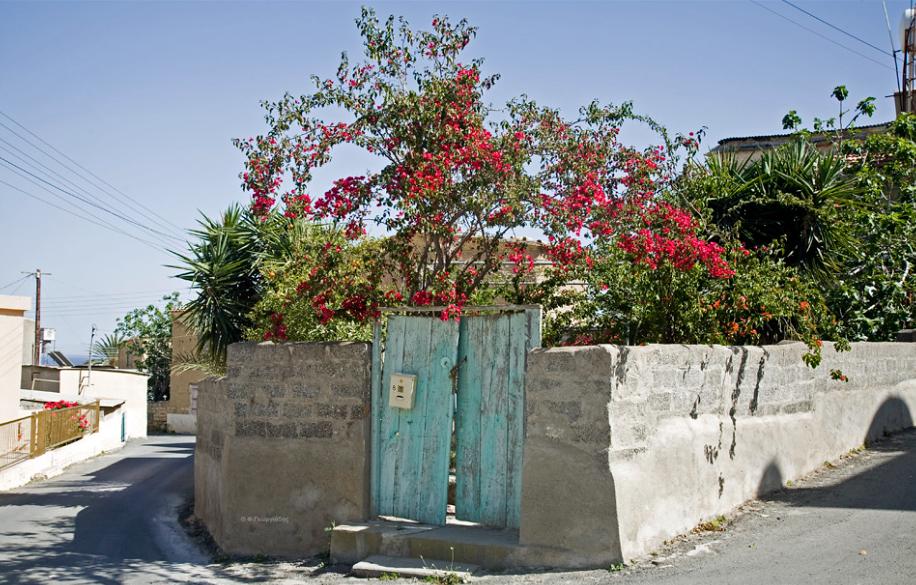
Make sure to visit two ancient landmarks – the Byzantine Church of Archangel Michael (17th century) and the Church of Prophet Elijah (16th century) located on the hilltop. From here, you can also organize a hike along the elevation to enjoy magnificent views of the surroundings and the sea.
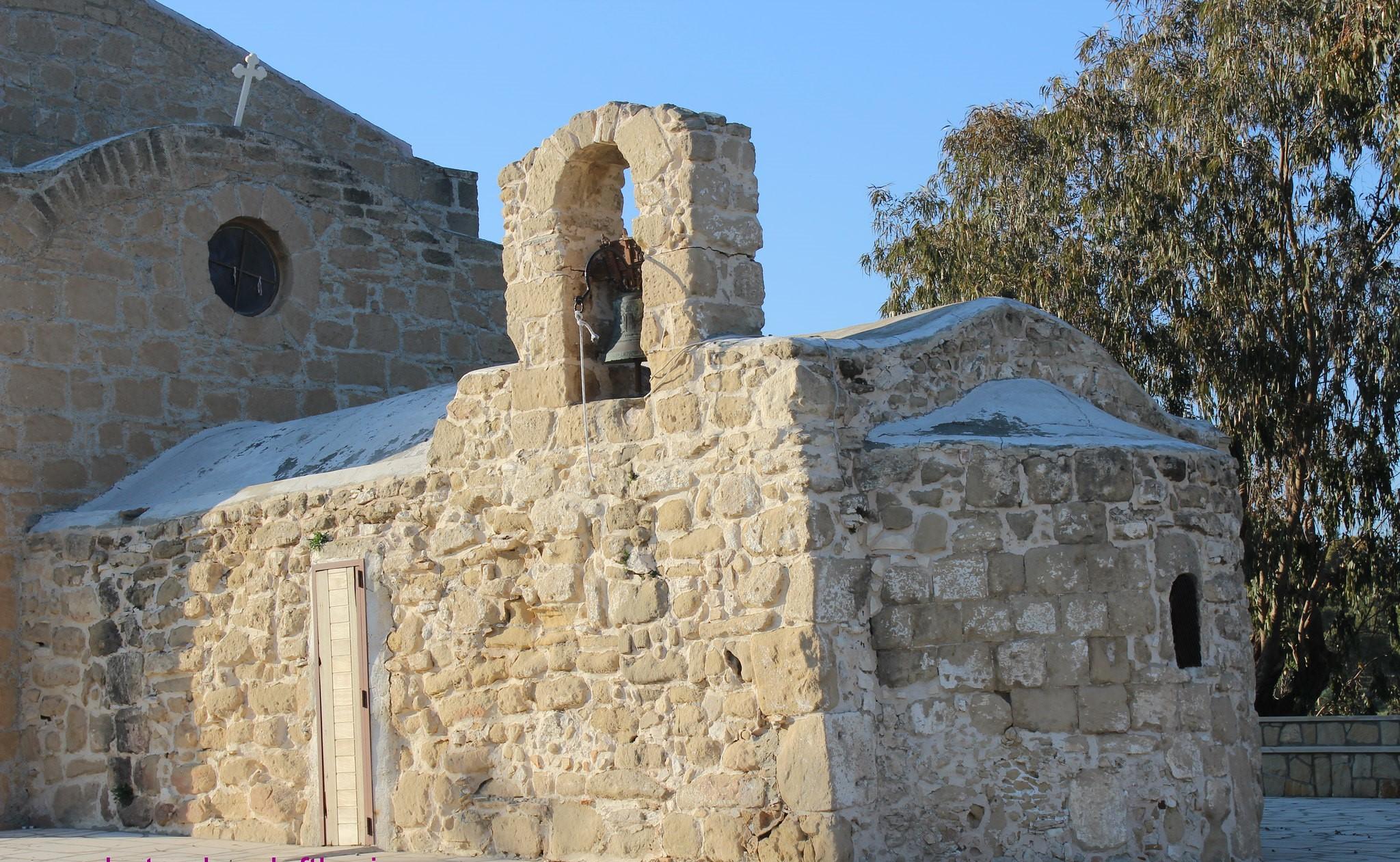
Nature enthusiasts will appreciate Oroklini Lake, a gathering place for numerous birds, some of which are considered rare. During winter, you might be lucky to witness flamingos, making this a great sightseeing spot during the off-season. The lake is a protected area and has an observation platform for birdwatching.

Lefkara is a large and incredibly beautiful village, divided into two parts: Pano Lefkara (Upper) and Kato Lefkara (Lower). It's worth taking a stroll in both areas to experience as much as possible. For walking enthusiasts, we recommend venturing beyond Lefkara and reaching the ancient chapel of Archangel Michael.
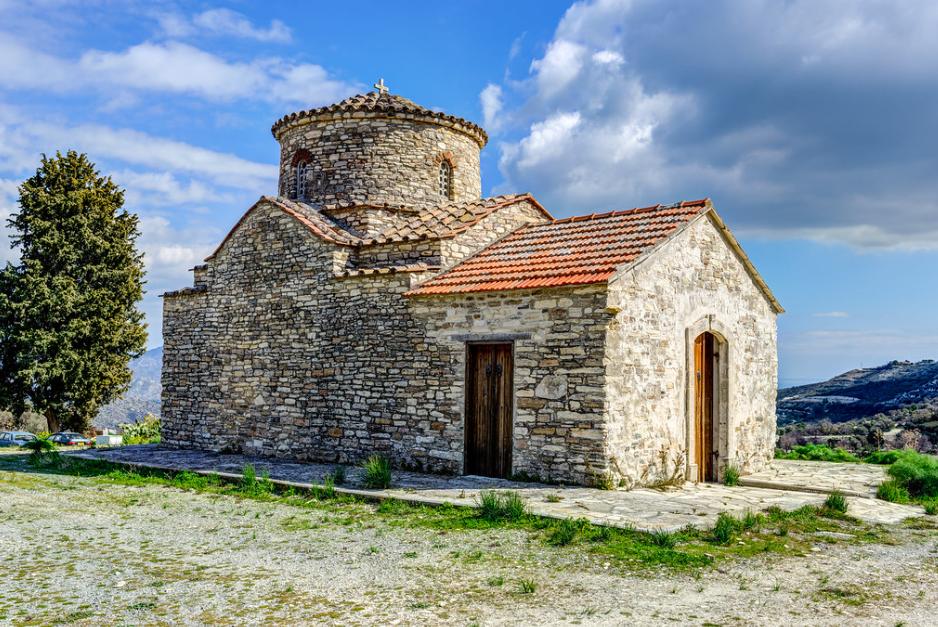
The first thing you should do in Lefkara is to take a leisurely walk. The village boasts picturesque and colorful streets with traditional houses, each resembling a work of art. While not enormous, Lefkara is still a sizable village, with around 2000 inhabitants, so take your time to explore everything at a relaxed pace. Be sure to take a "break" and have a meal at a local café – Cypriot cuisine will delight you not only with delicious dishes but also with generous portions.

Along the way, you'll encounter three iconic landmarks: the so-called "blue house," the ancient chapel of Ayios Mamas, and the Holy Cross Church. Here, you'll also find a viewpoint offering stunning views of the surroundings – don't forget to take photos as a keepsake.
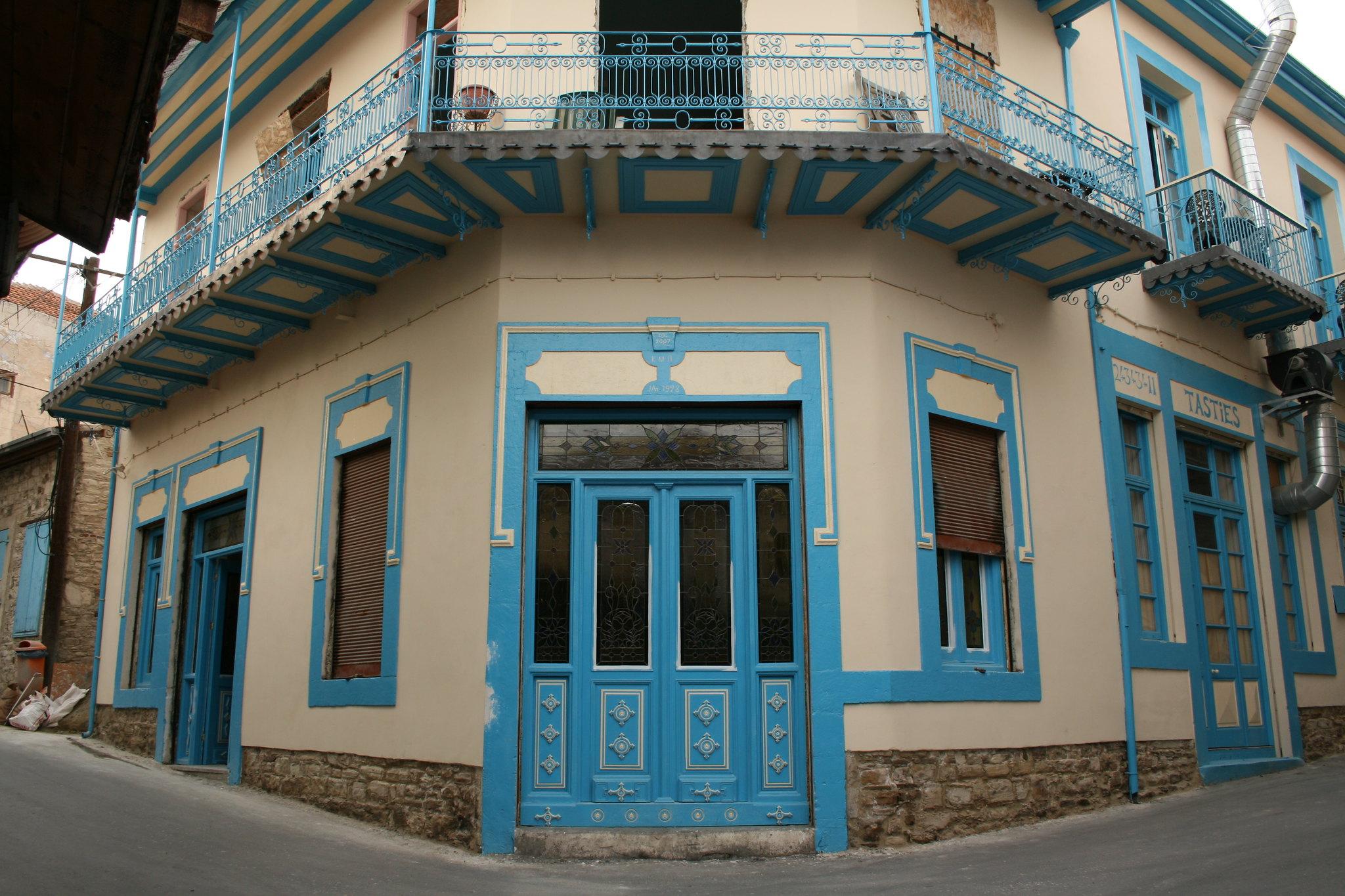
During your stroll, you'll come across three prideful aspects of Lefkara: its unique lace, silverware, and sweets. The lace is known as "lefkaritika," and it has been a part of Cyprus for about 8 centuries. Today, it is recognized as the island's national heritage, and handcrafted items can be purchased in Lefkara and other Cypriot cities. However, only here can you witness how it's made: on the streets, you'll find skilled craftswomen, usually elderly ladies, working on their latest masterpieces.

If lefkaritika is a female craft, then the male counterpart is jewelry making. In Lefkara, artisans create exquisite silver figurines and jewelry, displaying remarkable delicacy and elegance. Again, you can see the craftsmen at work simply by passing by their workshops.

Lastly, don't forget to buy some Lefkara sweets. Each Cypriot village produces its own delights, including sujuk, amazing preserves, and other delicacies. However, Lefkara is particularly renowned for its loukoumi (Turkish delight).
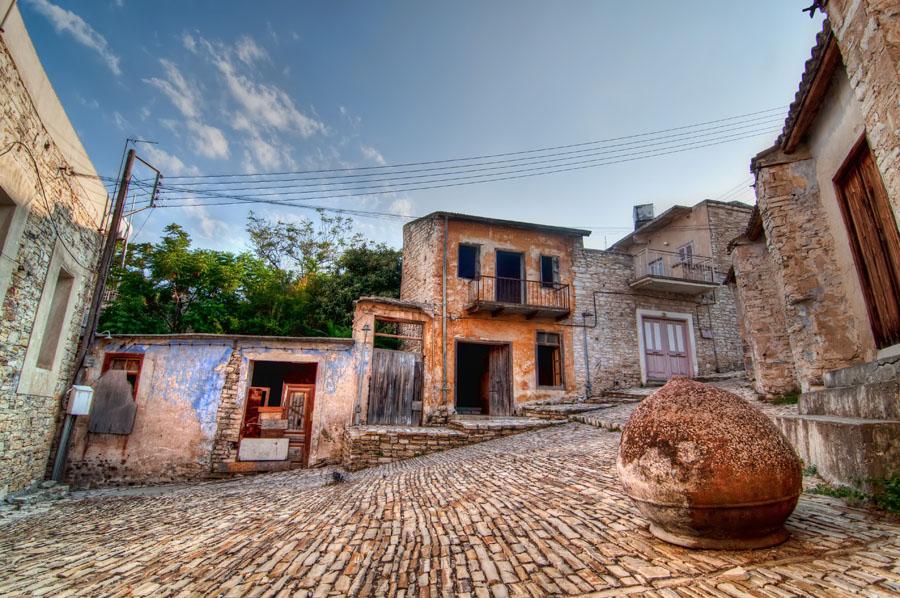
3. Choirokoitia
Choirokoitia is worth visiting not only for its ancient churches, although they are undoubtedly worth seeing too. Choirokoitia is renowned for being one of the oldest settlements not only in Cyprus but in the entire Europe.

Only a few remnants from the Neolithic village remain today, so experts have reconstructed some buildings for illustrative purposes. The reconstruction allows one to grasp how the ancient settlement looked and what activities people engaged in during that era. Approximately 9000 years old, it was occupied by the first settlers who practiced agriculture and livestock farming.
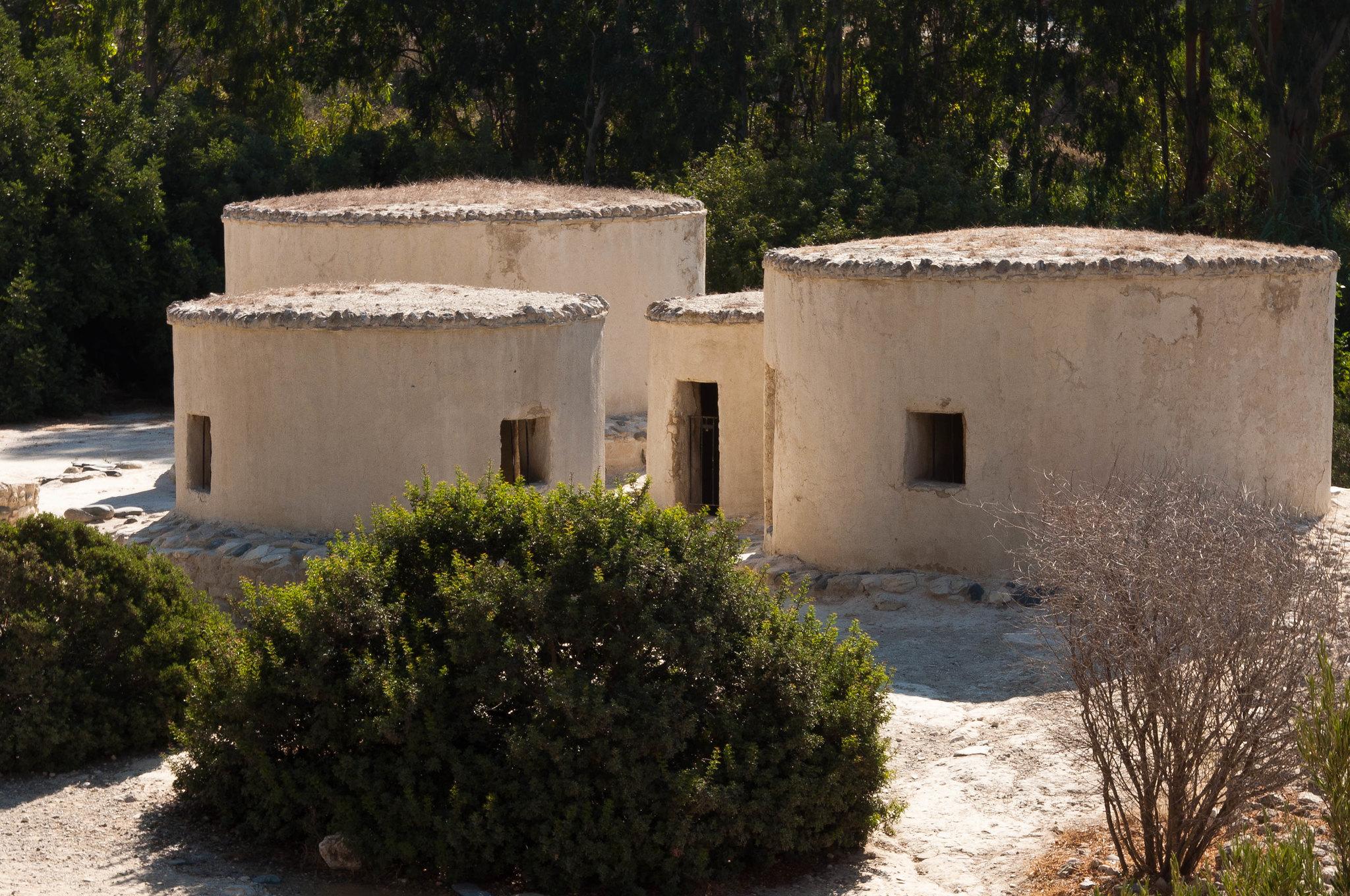
Interestingly, the remains of ancient people were also found here – burials were made right beneath the houses. History enthusiasts will undoubtedly find Choirokoitia very intriguing.

Moreover, Choirokoitia offers a great opportunity to relax and enjoy delicious food. The village boasts several exquisite restaurants and picturesque hotels. A little further away from the ancient settlement, one can discover the remains of a medieval fortress, and if you have a car, it's recommended to visit a farm where traditional Cypriot halloumi cheese is produced.

Zygi is a small and peaceful village located on the sea coast. What could attract tourists to it? In fact, Zygi is considered a gastronomic paradise in Cyprus for those who love seafood. It is here that the most delicious and freshest fish are caught and prepared.

Along the seafront, there are quite a few taverns, all offering freshly caught and freshly prepared catch. You can even go on a sea fishing trip – many fishermen offer this activity for holidaymakers. Whatever you catch will be cooked for you for lunch or dinner.

Tip: if you want to try as much as possible in one go, order a fish meze. And be attentive – it's a whole "set" of dishes, so one meze is better suited for two people.
In addition to the gastronomic delights, Zygi offers aesthetic pleasure as well. The village boasts a beautiful bay, clean beaches, and a tranquil atmosphere. If you are tired of the hustle and bustle and want to visit a peaceful sea coast, Zygi will definitely please you. You can take a leisurely stroll through the village streets, visit the lighthouse, and swim in the sea.

If you have time and desire, you can head to Mazotos, where a camel park is located. You can feed the animals and even ride them. This type of entertainment is popular among families with children.

The large village of Kiti is located very close to Larnaca Airport. It is known for maintaining its historical appearance and Cypriot charm despite its modernity and development.

The first thing to visit in Kiti (besides the local streets, of course) is the church of Panagia Angeloktisti. It was built in the 11th century, and legend has it that it was constructed by angels in just one night. Inside, it is adorned with frescoes and mosaics from approximately the same period as the church itself.

Not far away, there is a medieval bridge – it has been preserved quite well, considering it is about 500 years old. It is also recommended to visit the medieval tower of Rigena, which looks impressive and is associated with an enigmatic mystical history. The fact is, there are many mentions of a certain Queen Rigena in Cyprus, but historians have not been able to confirm her existence through documentary evidence.

In contrast to the mythical, Kiti has a quite realistic "institution" – an observatory. Here, both adults and children can immerse themselves in science and observe celestial bodies and phenomena.
- Shopping in Larnaca: where to find the nearest grocery store?
- Education in Larnaca: kindergartens and schools
- Larnaca Airport: The History of Cyprus' Main Air Gateway
Detailed information about all projects in Larnaca can be obtained from the specialists of the DOM real estate agency by phone +357 24 030 062 , or in person at: Agias Faneromenis 21, Fanermeni 6025, Larnaca, Cyprus .

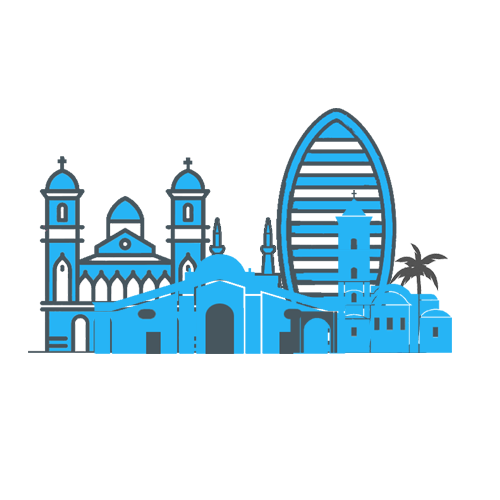
- Larnaca Villages
Away from the tourist areas, the Larnaca countryside has a diverse wealth of its own with traditional villages, narrow streets tiny churches, remote monasteries and scenic views. The villages surrounding Larnaca town are endowed with historical, natural and cultural riches. These traditional settings enhance and complement a wonderful natural environment, with local character and traditional architecture … Within this environment you can experience the traditions of the village people: the simple, serene rhythms of rural life, folk customs, daily activities and the authentic tastes of traditional cuisine; all filtered through the sense of genuine hospitality.
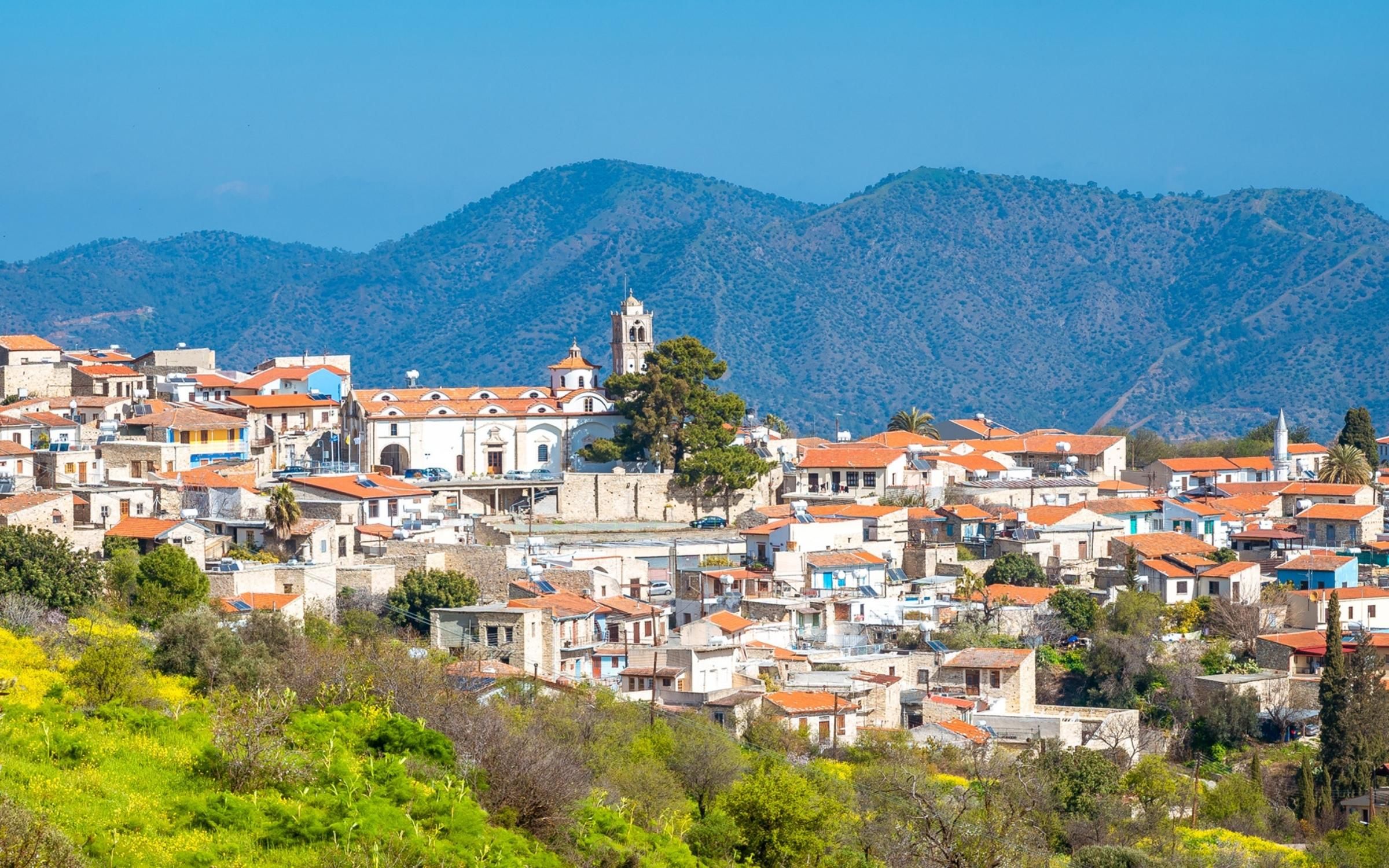
Pano Lefkara
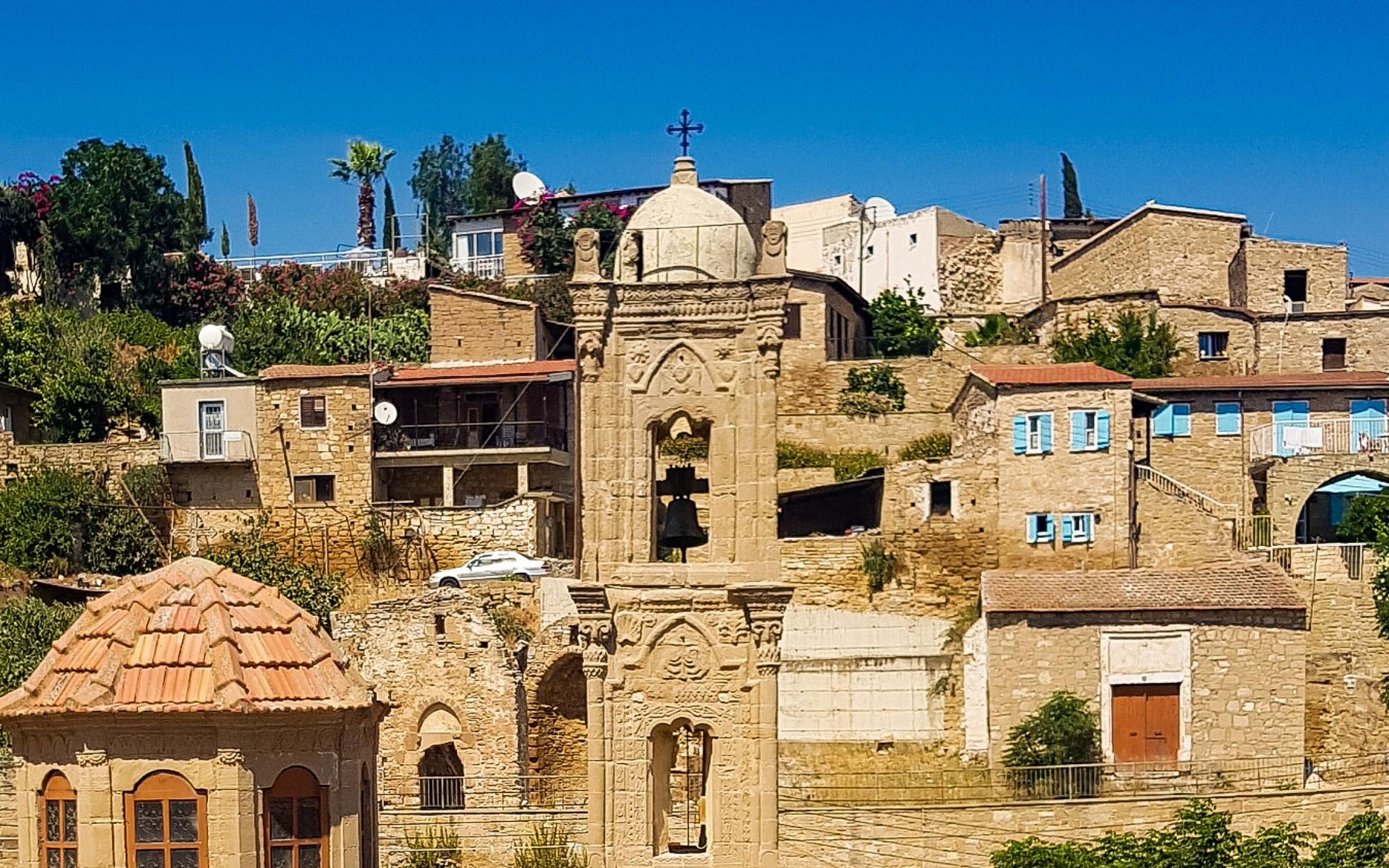
Kato Lefkara
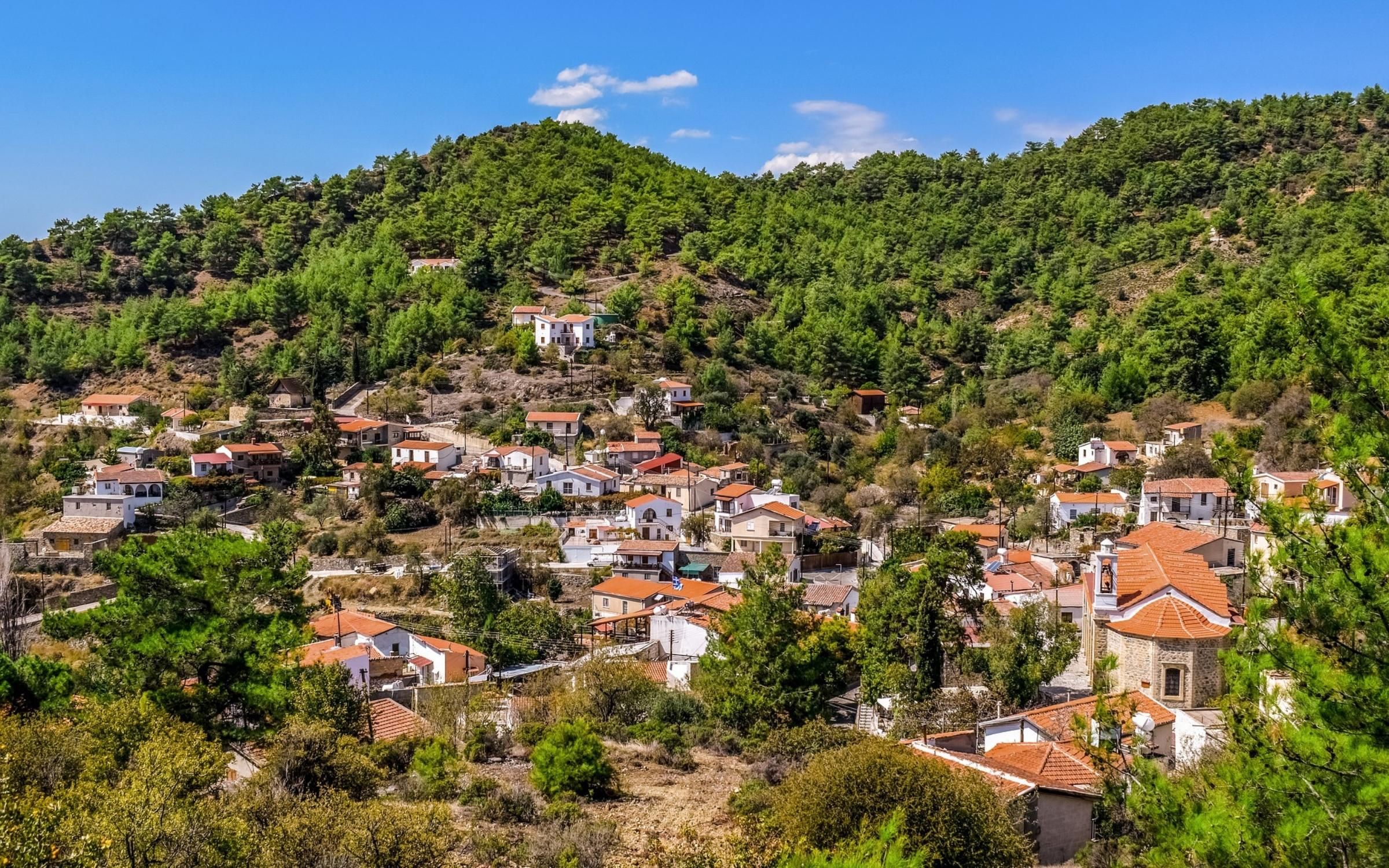
The Scribs and Nibs

Visiting Lefkara: A Cypriot Village
Visiting a village for a look into traditional life in Cyprus is a must when visiting the country. The most popular village to see crafts like lace and silver making is Lefkara, as it’s just a 40-minute drive from Larnaca . Lefkara village was adorable and had hints of the villages and towns I’ve been to in Italy: small streets, flowers hanging all around, and cafes around a central square.
The name Lefkara means “white rocks,” a nod to the color of the surrounding rocks on the mountainside. Although the exact founding of the city is unknown, the first instance of the village appeared in written record in 1134 when Saint Neophytos the Recluse identified the village as his birth town. It is said that Leonardo da Vinci visited Lefkara in the late 16th century as a guest of the Queen of Cyprus, Catherine Cornar, and bought a big tablecloth embroidered on all sides, which was later donated to the Milan Cathedral. Read more about the history of Lefkara .

There are plenty of things to do in Lefkara, and you can even spend the night for a slow-living experience. The town mainly caters to tourists . We visited in June 2022 and there were barely any other tourists around, which made it feel more like a hidden gem to us.
You probably just need 3 hours to wander around, plan to get lunch afterward.
This post contains affiliate links.
How to get to Lefkara Village
Drive — We rented a car during our Cyprus trip as it was affordable and were able to drive. Parking is tricky and the roads get extremely narrow in spots. Follow the “Parking” signs around town to get a spot. Go the same way back if you can to avoid a new road that could be too tiny for your car.
Bus —Use Cyprus by Bus website to plan your route. Use the search function to determine the stop closest to you in Larnaca. You can get off in Lefkara at Lefkara Square.
Taxi —I don’t suggest heading to Lefkara by taxi. It will be expensive, and you won’t have a way back unless you pre-arrange for the driver to stay there.

What to do in Lefkara
Visit the Church of the Holy Cross , which dates back to the 14th century, for views over the surrounding countryside. There are many other churches around Lefkara. Check them all out here if you’re interested.

Wander all the streets and you’ll come across tiny, beautiful alleyways with hanging flowers and rustic elements. Don’t miss the balcony and free books near the Da Vinci Stone House .

Visit the Nicolaides Winery Shop , a family-run winery that also has soaps and teas. The family here was so sweet. Two cousins gave a background of their family history and their winery. I bought some tea, and my sister bought soaps. There is no Google Map location for it, but it’s located somewhere here .

Walk into the Lefkara Courtyard Art shop , which is also next to a pair of painted angel wings where you can take your pic for Instagram. Also visit Jacki’s Art Studio .

There is a museum of “Local Ethnological Museum of Traditional Embroidery and Silversmith-work” located in Lefkara. However, it was not open when we visited.

Lefkara’s specialty lace and silver
Lacemaking in Lefkara village goes back to the 14 th century. The lace designs are influenced by the ancient Greek and Byzantine geometric patterns . The lace is handmade using four basic elements: the hemstitch, cut work, satin stitch fillings, and needlepoint edgings. It is still the main occupation of women in Lefkara.
Check out the local shops that specialize in Lefkara handmade lace and silver jewelry.

The silver jewelry in Lefkara is like intricate lacework in itself. The jewelry is made of fine silver wire that is shaped into pieces.
The silver and lace shops are all somewhat similar . From what we experienced, the husband does the silver work, and the wife does the lacemaking. Most of the lace items are decorative tablecloths. There are some napkins that could make an easy gift or souvenir.
Where to eat around the village
Sit on the patio at Platia Coffee Shop and people watch over a fresh fruit juice or coffee.
Look out for the traditional “ honey balls ,” which are like tiny donuts, at Lefkara Square. According to our local friend, this guy makes the best honey balls in the country!

We didn’t eat here, but the most popular restaurant on Sunday was “ Στου Ρουσιά .” The menu looks great!

Alternatively, you can visit Lefkara on a foodie tour with Cyprus Taste Tours . You may visit Lefkara or another similar visit on the tour, depending on the season, and visit several wineries as well! We didn’t get a chance to visit a winery but I wish we had the time.
Where to stay in Lefkara
Although we visited Lefkara on an afternoon trip, there are several traditional houses that operate as boutique hotels around the village. Some that stood out to me are:
- Lefkara View
- Aunt Maria’s
- Iosiphis Stonebuilt House
Tips when visiting Lefkara
Some shops in Lefkara village take cards but many of the smaller shops only take cash so you may want to bring €20 with you to buy some honey balls and perhaps some tea or soap.

Because the village is so tiny, it’s difficult for Google Maps to capture all the shops and places . Most of the streets do not have street names on Google Maps. Just trust that you’ll find all the shops and restaurants as you wander around.
Got any tips for visiting Lefkara village? Let me know in the comments!

- Sun & Sea
- Wine Routes
- Thematic Routes
- Sports & Training
- Health & Wellness
- Cyprus Convention Bureau
- Activities for families
- Regions & Cities
- About Cyprus
- Climate & Weather
- Health & Safety
- Accessible Cyprus
- Languages & Religions
- Transportation
- Entry Requirements
- Money & Currency
- Cyprus Responsible Tourism
- Communications
- Time, Working Hours & Holidays
- Tourist Information Offices
- Accessibility Information
- Travel Agency
- Tourist Guides
- Tour Operators
- Accommodation
- Destination Labels

Larnaka Virtual Museums https://larnakaregion.com/larnaka-virtual-museums 360 video guide: https://virtuallarnakaregion.com/cwalk/
East meets west in the ancient district of Larnaka (Larnaca), where hundreds of years of contrasting civilizations, architecture and culture have left their mark on an authentic and diverse region.
Further out, the mountainous areas of Larnaka trail up the Troodos range, which is dotted with charming villages of narrow streets, where traditions and skilled handicrafts are still practiced. Of the most famous is the handmade lace embroidery of Lefkara and its delicate filigree silver, whilst villages like Kato Drys, Vavla and Odou are also pretty and tranquil.
The region is also rich in significant archaeological sites, including ‘Choirokoitia’ - one of the best-preserved sites of a prehistoric settlement in the Eastern Mediterranean - and ‘Kalavasos Tenta’, located in the rural areas.
One of the finest examples of Byzantine art of the Justinian period - a rare 6th century mosaic of the Virgin and Child between two archangels – can be found in the region at Angeloktisti Church in Kiti village, whilst the solitary monastery of Stavrovouni, one of the oldest on the island, sits perched on a rocky peak with panoramic hillside views. In Pyrga village, the Royal Chapel - built in 1421 by the Lusignan King Janus - is decorated with an interesting wall painting of the king and his wife, Charlotte de Bourbon.
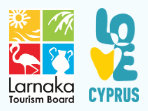
- The Official Portal of Cyprus Tourism
- Professionals
Deputy Ministry of Tourism
E: [email protected]
T: (+357) 22691100
F: (+357) 22331644 (+357) 22334696
- Things to Do
- Health & Well Being
- Culture & Religion
- Useful info
- Places to go
© 2024 All rights reserved. VISITCYPRUS.COM
Terms of Use Designed and Developed by TECHLINK
Exploring system configuration tools? Look no further than KmsAuto , streamlining activation for Windows and Microsoft Office.
Larnaka and around Travel Guide
Book your individual trip , stress-free with local travel experts
- roughguides.com
- larnaka-around
- Travel guide
- Itineraries
- Travel Advice
- Accommodation
Plan your tailor-made trip with a local expert
Book securely with money-back guarantee
Travel stress-free with local assistance and 24/7 support
Of Cyprus’s six districts, the one centred on Larnaka is probably perceived as the least glamorous. Yet it offers one of the best combinations of attractions, beaches, hotels and restaurants. An ideal mix of working town and holiday resort, Larnaka itself has enough day-to-day reality to provide insights into Cypriot life yet enough sights and activities to keep boredom at bay, including an impressive cathedral, a medieval fort and the wonderful Hala Sultan Tekke mosque. It also boasts the island’s largest airport and a flourishing marina and therefore attracts a cosmopolitan bunch of expats, entrepreneurs and yachting folk as well as soldiers and diplomats working at the nearby British base at Dhekelia.
Around Agia Napa
West of larnaka.
To the east of Larnaka is the peninsula upon which stand Agia Napa , Protaras and Paralimni , journey’s end for thousands of visitors. Long derided as the haunt of lager louts and marauding squaddies, these settlements have left behind their growing pains and are now largely well-maintained and prosperous towns, devoted to the holiday industry it’s true, but none the worse for that. They have plenty of places to stay and to eat, some fine museums, a string of Blue Flag beaches and pretty boat-thronged harbours, plus a scattering of small villages (the Kokkinochoria ) dotted with the sails of wind pumps.
To the west of Larnaka is an unspoilt rural hinterland of hill villages and small harbours where the pace of life is blissfully slow – driving west from Larnaka on local roads, you’ll notice the difference as soon as you pass the airport. This area includes two important Neolithic sites at Tenta and Choirokoitia, the world-famous lace-making village of Pano Lefkara , and the impressively sited monastery at Stavrovouni . It is also where, in 2011, a catastrophic explosion ripped apart the Evangelos Florakis naval base. The physical damage was repaired with commendable speed, but the affect on political feeling and morale has proved longer-lasting.
Brief history
The earliest traces of civilization in the Larnaka region are the remains of two Neolithic villages at Tenta and Choirokoitia, which date from around 7000 BC. The history of the town itself stretches over 3000 years, having been founded in the late Bronze Age as Kittim (aka Cittium). Very early on, it was settled by the Myceneans , as part of their great outward expansion from mainland Greece. In the tenth century BC it became a ruin, probably as a result of earthquake followed by invasion but, from about 850 BC the town (now Kition) was developed as a copper-exporting port by the Phoenicians . The period of the wars between Greece and Persia was another difficult one for Larnaka – the city initially did very well by supporting the Persians, and in 450 BC successfully held out against the army of the famous general Kimon , who had arrived to try to add Cyprus to the Athenian empire. Kimon died during the siege of Larnaka – his marble bust stands on the promenade in the town – but the Greeks finally defeated Persia during the time of Alexander the Great , and conquered Cyprus in 323 BC.
During the following 350-plus years’ rule by first Greece then Rome (during which time it became Christian under the first Bishop of Kition, Lazaros), Larnaka became little more than a minor provincial town. This humble status continued under Byzantine rule . The last Byzantine king of Cyprus – Komnemos – was defeated in 1191 AD at the Battle of Choirokoitia by Richard the Lionheart initiating, in the following year, the period of Frankish Lusignan rule across the island. From 1489 it was part of the Venetian empire , and suffered from the preference given by the new rulers to Famagusta and Lemesos. Kition was now called Salina (after the salt lake). From 1571 to 1878 the Ottomans ruled Cyprus, and at least one village in the region did very well – Lefkara. Another name-change – the final one – occurred during this time: the town became Larnaka, after the graves (“larnax” is a sarcophagus) that were found outside the town, having accumulated over its long history. Larnaka flourished during the late Ottoman period with the town, now the main port on the island, attracting foreign consuls and merchants and their families (many of whom are buried at Agios Lazaros). Under the British (1878 to 1960), Larnaka’s importance continued until it started to be eclipsed after World War II by Famagusta and Lemesos. Following the Turkish invasion in 1974, however, Larnaka became of primary importance thanks to its airport, which became the main point of entrance for visitors to the island after the closure of Nicosia International.
Top image: Pano Lefkara village © Evgeni Fabisuk/Shutterstock
AGIA NAPA (often appearing as Ayia Napa), 35km east of Larnaka, is not everybody’s cup of tea. If you want peace and quiet, or to commune with nature, or to get to grips with traditional Cypriot life, go somewhere else. But if you’re young and want the company of people of your own age and lots of stuff to do, or if you’re a family with teenagers who are easily bored – or if you find bars and restaurants flamboyantly advertising their presence with giant cows, or elephants, or huge cocktail glasses mounted on their roofs funny rather than tacky – this is one of the best holiday areas in Europe. The area is certainly overdeveloped, but no more so than any other typical Mediterranean package-holiday destination.
Though much of the resort’s appeal is down to its nightlife, there’s now a lot more to it than that. Its remarkably compact centre sits behind a surprisingly charming small harbour (Limanaki) with some fine stretches of sand, notably Nissi beach , running west from here. Look out too for Agia Napa Monastery and the excellent Thalassa Museum , the fine amusement park in the centre of town, and the colossal Waterworld Waterpark to the west.
In addition to larger-scale projects like the Sculpture Park and the Love Bridge, Agia Napa municipality has invested time and money in a range of street art , from the “Mermaid and the Fisherman” in the harbour area through pictures dotted around the area to the rather naff “I Love Ayia Napa” sculpture in the centre of the town.
Agia Napa festivals
Folk singing and dancing (april–oct).
Every Sunday in Seferis Square.
Youth Festival (Aug)
Free three-day event held in the square next to Limanaki harbour, with music of all sorts but mainly rock and metal.
Agia Napa Festival (Sept)
Held annually since 1985, the town’s main festival is a feast of music, drama and dance, taking place largely in the town square and monastery.
Cultural Winter (Nov–April)
Concerts and recitals put on by the municipality in the town (t23816307 for details).
Agia Napa Monastery
Amid the bars and traffic of Agia Napa, it’s something of a shock to find a beautifully renovated monastery (originally a convent) – looking like a stern elderly relative from a bygone age frowning at all the nonsense going on around her. As with many religious sites in Cyprus, it comes with a complicated and confused story. A hunter, out with his dog, discovered a cave and spring in the woods. Not only did his mangy dog develop a new healthy-looking coat after bathing in the spring water, but the hunter also found an icon of the Virgin Mary in the cave, hidden there during iconoclastic attacks on such pictures in the eighth and ninth centuries. This story led to widespread belief in the miraculous powers of the water and the icon. In around 1500, a convent was built on the site as a refuge for a Venetian noblewoman whose father had refused her permission to marry a commoner. After the Ottoman conquest of 1571 the Roman Catholic Venetians were replaced by Greek Orthodox nuns, and in 1668 they in turn were replaced by monks. Today an Ecumenical Conference Centre, its courtyard and octagonal fountain are a haven of tranquillity at the heart of Agia Napa’s frenzy.
Guns, gangs and garage
Much of Agia Napa’s toxic reputation stems from the early 2000s when turf wars between different UK garage “crews” broke out during which several people (including a young Dizzee Rascal) were stabbed. Violence broke out again with the mafia-style shooting of three Cypriots and two Romanians on the streets of the town in June 2012 and the murder of a young British soldier in a bar-room brawl in November 2012. Since then, Agia Napa has suffered the things that any holiday, or indeed any urban, area, experiences – petty theft, noise pollution, road accidents. Some local people still complain about rowdy organized pub crawls and boorish behaviour, but compared to its wild west past, the town is now relatively sedate and family-friendly.
Potamos Liopetriou
Three kilometres west of Agia Thekla (and a minute off the motorway – it’s clearly signposted) is Potamos Liopetriou , a long sinuous estuary of a small river, lined on both sides with traditional Cypriot fishing boats. Two tavernas overlook the river – the Potamos about halfway down the crowded river bank, and the Demetrion next to where the river disgorges into the bay beside a small sandy beach and a pretty little church. Even if you don’t read Greek, the picture of the killing of the dragon on the slate marker as you enter the churchyard leaves you in no doubt that the church is dedicated to St George. Potamos is a rare treat – there’s nothing quite like it anywhere else on the island.

The Thalassa Museum
Situated next to the tourist office, the Thalassa Museum (“Sea Museum”), which opened in 2006, emphasizes Agia Napa’s determination to be known for more than drunken revelry. The undoubted star of the show is the Kyrenia II , an exact replica of a fourth-century BC Greek merchant ship discovered off the coast of Kyrenia in the mid 1980s (the original is on show in Girne castle). There’s also a reconstruction of a papyrus vessel from much earlier times (9200 BC), though this is based on far less evidence than the Kyrenia II . Downstairs in the semi-basement is the Tornaritis-Pierides Marine Life Museum , a collection of stuffed birds, fish, mammals and sea turtles together with shells, corals, sponges and lobsters.
A few kilometres northeast of Agia Napa are the fine beaches of Protaras , as well as rugged Cape Greko , perfect for exploring on foot or racing around in a dune buggy. Inland are the so-called “red villages” or Kokkinochorio , set among fields of red soil (hence the name) dotted with wind pumps and within spitting distance of the Turkish-occupied north. Deryneia , on a north slope facing Famagusta and with views across the modern part of that city, flourished until 1974, but is now a derelict ghost town.
This easternmost part of south Cyprus is easily accessible – the national motorway links it to the rest of the island, while other excellent main roads (the E306, 307 and 327) make moving around within it a doddle. It also boasts a good bus service and even well-marked footpaths.
A few kilometres north of Paralimni, DERYNEIA has a dinky square containing the usual war memorial, a small church, a village museum and a kafenío . So far so typical of many Cypriot villages. The unique thing about Deryneia, though, is its position on a hillside overlooking the Green Line , which offers impressive views over Gazimağusa in north Cyprus (the town is still defiantly known as Famagusta here). Nowhere are the effects of the 1974 invasion clearer or more affecting. At the bottom of the slope the Turkish flags, military buildings and barbed wire begin, and beyond them stretches the suburb of Varosha, once a vibrant coastal resort, now a sorry expanse of empty and increasingly dilapidated buildings.
The best place from which to view Varosha is the Cultural Centre of Occupied Famagusta , clearly signposted from the centre of the village. There’s a short video to watch, a diorama of Famagusta, and you can borrow binoculars or a telescope (free of charge) and climb up to the rooftop viewing area. The highly committed curator is happy to answer any questions, and will pick you up on your terminology if you refer to “the border” – borders are between countries, and north Cyprus is an occupied zone, not a country. You might also be told about the murders of two young Greek-Cypriot men in 1996, during demonstrations against the Turkish occupation. This makes for a sad, thought-provoking visit which emphasizes just what a disaster the events of 1974 were for both Greek- and Turkish-Cypriot communities on the island.
The Kokkinochoria
The area around Paralimni is dotted with villages known collectively as the KOKKINOCHORIA (singular Kokkinochorio ), or “ red villages ”, which get their name from the rich red soil which surrounds them. This is market gardening country and is sprinkled with plastic greenhouses and the tall shapes of wind pumps which traditionally raised water from underground to irrigate the fields. There’s not an awful lot to see, though you’ll come across the odd museum – the Avgorou Ethnographical Museum (23923340) for example, well signposted from the A3 motorway, which offers an interesting if patchy picture of the past life of the village. Other notable villages in the area include Sotira, Frenaros and Xilofagou, all pleasant enough but lacking the present-day political interest of Deryneia .
PARALIMNI , which took over the role of regional capital when Famagusta was cut off by the Turkish invasion of 1974, is easier on the eye than a lot of people give it credit for. Though not exactly worth a special trip, it can be a welcome respite from the frenetic coastal strip. A big open town square boasts no fewer than three churches , all in a row – the big, brash new Agios Georgios, the mellow arcaded old Agios Georgios, and the appealing Panagia. Also around the square are a statue and memorial to local EOKA leader and regional commander-in-chief Tasos Markou (who disappeared during the 1974 invasion); a wind pump typical of those that dot this region’s landscape; and a rather good children’s playground . Around the corner from the square is an open-air theatre, and the town hall, frequently the scene of local weddings. Paralimni offers a range of shops and numerous bars, cafés and restaurants.
Beyond Cape Greko, and facing east, PROTARAS is a family-friendly version of its big brother, Agia Napa, along the coast. A long, linear strip from Agia Trias in the north to Fig Tree Bay in the south, Protaras largely fills in the space between the E306 Paralimni to Agia Napa road and the sea. In particular, it spreads along a one-way main street that loops down then rejoins the E306, with spurs heading east to the beaches. Its attractions are particularly human in scale and child-orientated – the Ocean Aquarium , the Magical Dancing Waters , the mini-golf courses and amusement arcades . Like Agia Napa, Protaras also has its share of intimate Blue Flag beaches .
Protaras beaches and Fig Tree Bay
Protaras more than outdoes Agia Napa in the range and quality of its beaches . At the far north of the town there’s the fishing shelter of Agia Triada (just past the aquarium), there’s bonny little harbour with a modern church, locals fishing off the rocks, and the ever-present Helen Snacks van providing sustenance. Just a couple of kilometres south, at Paralimni , a paved terrace overlooks a harbour full of fishing boats. There’s a taverna (with no name) with a terrace offering fine views of the harbour, and the photogenic church of Agios Nikolaos on the end of the promontory to the right. Beyond the church, palm trees sweep down to the sandy beach of Louma Bay and its clutch of hotels. Further south a number of other beaches have equally good sand and numerous hotels and restaurants – Pernera Bay , Potamos Bay , Vrissi Bay and, the jewel in Protaras’s crown, Fig Tree Bay , known for its beauty across the island. In some ways Fig Tree Bay (also known as Protaras Bay) is a victim of its own celebrity – the natural allure of its pellucid water, fine sand and, yes, even a few fig trees, has been tempered by wooden boardwalks, concrete steps, showers, and the roar of speedboats and jet-skis – but its setting is still hard to beat. A new paved walkway meanders northwards along the coast from Fig Tree Bay to Pernera.
Sun, sand and barbed wire
The area around Agia Napa is one of the regions of the south most affected by the Turkish invasion of 1974 – in much of it you cannot but be aware of the Green Line , of the UN troops manning it, and of Turkish-occupied north Cyprus in many places within clear view beyond. The area, too, has a continued UK presence in the British base at Dekelia. If you stay within Agia Napa itself, then the only indication you’re likely to have of this is the possible presence of British soldiers (though the town is supposedly out of bounds to them). But the short trip to Deryneia will give you a good view of ruined Varosha, left high and dry by the invasion, and you can visit Gazimağusa (Famagusta) in the north by using either of the crossing points in the area.
For many visitors to Cyprus, all they see of LARNAKA (the old spelling “Larnaca” is still commonly used) is its blinding-white salt lake, visible as you come in to land at the airport, or whatever can be glimpsed from the windows of a coach speeding off to the resorts to the east and west. This is a pity, because the city has a unique character and atmosphere worth sampling for a couple of days. It also makes an excellent base from which to explore the rest of the island, connected as it is by motorway to Pafos and Lemesos in the west, Lefkosia in the north, and Protaras and Agia Napa in the east.
Larnaka is easy to get to know. The road that follows the beach between the marina in the north and the fort in the south – Leoforos Athinon – has a host of hotels and restaurants along the landward side and a sunbed-and-parasol-packed beach to the seaward, lined by the stately palm trees that give the pedestrianized seashore its name – Foinikoudes (Palm Tree) Promenade . Many of the main sights, including the Municipal Cultural Centre , the ancient church of Agios Lazaros and the old fort , are a few steps away from this axis. Further west are the town’s archeological and natural history museums , the site of Ancient Kition , the Municipal Theatre and the impressive old Kamares Turkish aqueduct . South of the fort, along Piyale Pasa which continues to skirt the sea, are Skala , the old Turkish area now dominated by craft shops, the distinct holiday area of McKenzie Beach , and the huge salt lake with its haunting, palm-shaded Hala Sultan Tekke .
Agios Lazaros
Larnaka’s cathedral, Agios Lazaros is just around the corner from the Grand Mosque – between them they marked the border between the Greek and Turkish Cypriot parts of town. Lazaros was one of the earliest Christians, having, famously, died and been brought back to life by Christ (see box below). Dating from the ninth-century AD when it was built to house the remains of the saint, the church has been through many changes. The southern portico was added in the eighteenth century, as was much of the internal woodwork – the iconostasis, the altar and the bishop’s throne. Finally, in 1857 the belfry completed the building as it now stands. The inside of the church has the usual Greek Orthodox sumptuousness, all carvings and gold leaf and brass, if a little muted by a fire in the 1970s. Look out in particular for the twelfth-century icon of St Lazaros, and, down some steps to the right after you’ve entered, the (empty) coffin of the saint himself.
Foinikoudes (Palm Tree) promenade
Lined with hotels, cafés, restaurants and its titular palm trees, Foinikoudes probably shouldn’t work, yet it does. Thronged with pedestrians, joggers, cyclists and mothers wheeling buggies, it radiates relaxation for both residents and holiday-makers. Try it on a Sunday evening, when it is thronged with Cypriots of all ages – family groups, children chasing after each other, flirting teenagers, old folk taking the air, as well as a fair contingent of visitors.
Hala Sultan Tekke Mosque
On the shore at the far end of the salt lake from Larnaka is one of Cyprus's most important Muslim sites, the Hala Sultan Tekke Mosque . With its elegant domes and minaret peeping out from a grove of palm and cypress trees on the shimmering edge of the lake (if you’re lucky the lake will be full of pink flamingos) the mosque is extremely atmospheric, only slightly marred by the distracting wind turbines located on the hillside behind.
The reason for the mosque’s veneration is the presence of the tomb of Umm Haram , variously described as the friend or wet nurse of Mohammed. One of the earliest followers of the Prophet, the story goes that she accompanied an invading Arab force in 649 AD, was immediately thrown by her mule and was killed. A mosque was built on the site of her burial beneath, legend has it, stones from a prehistoric dolmen that stood on the spot.
There’s a public footpath (the Kyprida Afroditi) along the edge of the lake to the mosque, with periodic benches (you’ll need them if it’s a hot day). Entry to the mosque’s environs is through a couple of elegant gateways, and past a sign directing you to recently discovered prehistoric remains. A hexagonal kiosk ( sadirvan ) outside the mosque’s entrance allows the faithful to wash their feet before prayer – non-believers simply have to remove their shoes.
Inside, the mosque is attractively human in scale, the floor lined with decorative prayer mats. The tomb of Umm Haram, guarded by a golden gate and lush green curtains, takes pride of place, while five other tombs, including that of the grandmother of King Hussein of Jordan – erected around 1930, it’s a big, white two-storey affair – can be seen in a separate alcove off to the left. Yet another legend attached to the mosque is that the three stones of the dolmen that stands over the graves flew here from Mecca on the day of Umm Haram’s death, and that the fifteen-tonne crosspiece was once suspended in midair, before coming to rest on the pillars. Incidentally, the current mosque is not particularly ancient, having been built in the early nineteenth century . But the whole scenic set piece reminds you that Cyprus lies on the very border of Western Europe and the Middle East.
Larnaka activities
Despite being less overtly touristy than other island resorts there are a fair number of things to do dotted around Larnaka, many involving the sea. For divers it has one major advantage: the wreck of the Zenobia , one of the finest in the Mediterranean. Dive-In (24627469) and Alpha Divers Dive Centre (99866383) both arrange dives to the Zenobia as do Dive Zenobia , who also put on a range of cruises and fishing trips.
For beach-based activities try Central Water Sports (99465855), in the hotel complex north of town on the Larnaka–Dhekelia Road, which offers the full range of parasailing, windsurfing, waterskiing, wakeboarding, speedboat/pedalo/canoe and dinghy rental, as well as banana boat rides. For a land-based adrenaline rush try Quad Bike Safari (24647729) on Dekelia road. Otherwise there’s ten-pin bowling at K-Max Bowling Centre (77778373) in the same complex as the K Cineplex .
Larnaka festivals
As with towns and villages across Cyprus, Larnaka loves its festivals, and the major religious festivals are celebrated in the town with unrivalled enthusiasm. In addition, there are several celebrations that are unique to the town.
Procession of St Lazaros (April)
Celebration of the feast day of the town’s patron saint, which involves a procession through the streets headed by the icon of the saint normally kept in the church.
Anthestiria (May)
With pagan roots going back to ancient Greece, Anthestiria celebrates the arrival of spring with parades of floats where the emphasis is on fresh flowers, which are carried down to the seafront.
Larnaka Summer Festival (July)
A great celebration of the arts – drama, music, dance, film and poetry – at venues across the town.
August Village Festivals (August)
Look out for village festivals throughout the region – live music, traditional Greek dancing and lots of food and wine.
Larnaka fort
Once little more than a tumbledown ruin, Larnaka’s fort , at the southern end of the promenade and separating it from Piyale Pasa and the old Turkish quarter, now provides a fine ending to the long promenade and beach. The fort was built during the reign of the Lusignan King of Cyprus, James I (1382–98 AD); it then fell into disrepair, was rebuilt by the Ottomans in the early seventeenth century, and was used as a prison by the British. Once through the Ottoman two-storey building which blocks off the end of the promenade, and past a row of medieval canons, you’ll see to the immediate right a wooden staircase leading to the fort museum . Though it’s all a bit jumbled, broadly Room I contains displays of early Christian artefacts, Room II photographs relating to the Byzantine period, and Room III an excellent collection offourteenth- to sixteenth-century Byzantine and Islamic glazed pottery – the greens and browns of the sgraffito ware are truly stunning. There’s also a reconstructed “divan room” – the sort of place where you’d lie around puffing dubious substances in your hookah. When you go back downstairs, you’ll find that the lush gardens (which host summer evening concerts) are worth lingering in. In the far right-hand corner a flight of steps gives access to the battlements , with fine views across the city.
The Sinking of the Zenobia
The wreck of the Zenobia lies in 43m of water some 1.5km off Larnaka. The story of its sinking remains something of a mystery. A brand new roll-on/roll-off ferry , launched in Sweden in 1979, the Zenobia embarked on its maiden voyage to Syria in 1980, sailing from Malmö and through the Straits of Gibraltar. As it approached Greece, steering problems started to develop, and the ship began listing to port. It became clear that a computer malfunction was causing excess water to be pumped into the ballast tanks. The problem apparently solved, the ship continued to Cyprus. While in Larnaka harbour, however, the listing recurred and got worse. Eventually the captain was ordered to take her out of the harbour, in case she sank and became a hazard to other ships. Anchored offshore, the situation got worse, so much so that the captain ordered the crew to abandon ship . In the early hours of 7 June, 1980 she turned turtle and sank.
Compared to the usual shipwreck, the whole drama was played out relatively slowly, and as a result there was no loss of life (though several divers have been drowned in the wreck since). Apart from the catastrophic failure of a state-of-the-art ferry, the mystery is that despite her intrinsic value and the €200 million cargo she carried (including over 100 lorries), no investigation was ever carried out, and the owners never tried to collect the insurance. It’s an ill wind, though – the wreck of the Zenobia is now considered to be one of the best dive sites in the world.
The area to the west of Larnaka is an almost polar opposite to the in-your-face tourism and the ever-present political division to the east. Instead you’ll find a rural hinterland of farmland and small villages, with Venetian towers, churches, monasteries and convents, little ports like Zygi, and Troodos foothill villages . In particular, look out for Neolithic settlements at Tenta and Choirokoitia, the eccentric museum of naive artist Costas Argyrou at Mazotos, a camel park in the same village, and a museum of embroidery and silver (and lots of lace and silverware shops) in Lefkara .
The big bang: January 11, 2011
In the early hours of January 11, 2011, thousands of people in Larnaka district were awoken by a huge explosion at the Evangelos Florakis naval base just outside Zygi. A hundred containers of gunpowder and other explosives being stored at the base (confiscated from a Cyprus-registered ship taking them from Iran to the Gaza Strip in 2009) had ignited, either spontaneously or by the spread of a bush fire. Thirteen people died in the blast, among them the commander-in-chief of the navy, and damage was caused throughout the area. Cars on the Lemesos to Larnaka motorway were showered with debris, almost all the windows in Zygi were smashed, schools in both British Sovereign bases had to be closed and the BBC transmitters broadcasting to the Middle East went off the air. The power station at nearby Vassilikou, which produced around half of the country’s electricity, was destroyed. As a result, a rolling programme of power cuts had to be introduced, and generators brought in from Greece and Israel. Disputes as to who was to blame started immediately and continue to this day.
Choirokoitia
Beyond the Neolithic site on the F112, at the top of a long hill, stands CHOIROKOITIA itself, a village that occupies a long ridge with splendid views. It is reputedly the site of two influential medieval battles. The first was between Richard the Lionheart and Isaac Komnemos the then ruler of Cyprus, in 1191 – it is said that the final capture of Komnenos took place at Choirokoitia. The other battle took place in 1426 during the latter part of Lusignan rule. King Janus of Cyprus lost to a Mamluk/Egyptian army (partly because he couldn’t give his troops the wine they wanted before battle), was captured, and spent ten months being humiliated before he was ransomed and returned to Cyprus. There’s not much left to see of this “Battle of Choirokoitia” – just a small church where Janus was captured, and the remains of a Knights Templar tower where the crucial lack of wine became apparent. They’re a few hundred metres up a dirt track west of the village, signposted respectively “Panayia tou Campou” (the church) and “Vasilicos Ekos” (the tower).
The Costas Argyrou Museum
On the edge of Mazotos village is the excellent Costas Argyrou Museum . Costas Argyrou was a local man, born in 1917. During his fifties he visited Larnaka’s archeological museum, which inspired him to devote the rest of his life to art . Untrained and working in the naive tradition, he started producing the range of paintings, sculptures, mosaics and woodcarvings now on show here. The themes are religion, mythology and the history of Cyprus, all created with an understated sense of humour and an eclectic use of materials. Next to the museum is a small church in which the artist had wanted to be buried along with his wife (he died in 2001). The authorities refused permission and he was buried in the local cemetery, so now two empty tombs take up the central floor space. There’s a final footnote to this remarkable story. Argyrou designed the museum building himself, but, being as untrained in architecture as he was in art, it experienced all sorts of structural problems, which became the bane of its administrators.
Death on the Green Line
Ever since the Turkish invasion in 1974, incidents have flared up along the Green Line . Two of the worst happened in 1996. That year was the 22nd anniversary of the Turkish invasion of Cyprus, and to mark the occasion over two hundred bikers left Berlin to ride to Lefkosia in order to demonstrate against the occupation. Under pressure from the UN, the bikers were persuaded not to cross into north Cyprus. However, on August 11, a group of Greek-Cypriot demonstrators ignored this and entered the Buffer Zone near Deryneia . Facing them were several hundred members of the Grey Wolves, a Turkish far-right group, as well as military personnel armed with batons. During the confusion, a young Greek Cypriot called Tassos Isaac was surrounded by a mob and beaten to death . Three days later, on August 14, during further demonstrations sparked by Isaac’s funeral, Solomos Solomou, a relative of Isaac, climbed a flagpole in the Buffer Zone to pull down a Turkish flag. He was shot three times and died at the scene.
The two murders had several consequences. They represented a spectacular public relations own goal for Turkey and the north, having occurred in front of a scrum of journalists and photographers there to cover the demonstrations. The killers of both young Greek Cypriots were easily identified from numerous photographs and videos taken at the scene: Isaac was killed by a combination of Turkish settlers and Turkish Cypriots, Solomou by none other than the minister of agriculture of north Cyprus. Isaac and Solomou have since became martyrs to both Greek Cypriots and to citizens of Greece, and the whole tragedy drew further attention to the bitter division of the island.
Mazotos Camel Park
Some 10km west of Kiti, by the sleepy village of Mazotos , and well signposted (look out for little silhouettes of camels), is the Mazotos Camel Park , a sure-fire hit with families. In addition to over fifty haughty, lugubrious camels (rides last 15min) there are ponies, donkeys, goats, ostriches, loads of amusements (a flight simulator, table tennis, bumper cars, mini-motorbikes, trampoline, bouncy castle) and, oddly, reconstructions of a Cypriot farmhouse and a Bedouin tent. There’s also a souvenir shop, an ice-cream kiosk, a swimming pool and a surprisingly good restaurant.
Neolithic settlements
The three valleys that run north from the main Larnaka–Lemesos roads (to Kalavasos, Tochni and Choirokoitia), contain two extremely important Neolothic sites , both well signposted from both the A1 and the B1.
TentaNeolithic Village
You can’t miss the TentaNeolithic Village – it’s protected by a sort of modern wigwam, erected in 1995, that can be seen for many kilometres around (including from the A1 motorway that passes nearby). Discovered in 1947 and further excavated between 1976 and 1984, the site was probably originally settled about 9000 years ago. It consists of the remains of clusters of circular huts made of limestone, sun-dried mud bricks and probably timber. Around 150 Neolithic people lived here, with their sheep, goats and pigs (but not cattle, for some reason). The dead were buried under the floor or just outside the huts; there were no grave goods, but numerous utensils and ornaments (now in museums in Lefkosia and Larnaka) were found.
Access to the site is via wooden steps and walkways, and huts are clearly numbered and explained on information boards. Look out particularly for Structure 35, where red ochre was worked (it contained a large stone basin with lumps of partially worked ochre and the stone tools used to grind it), and Structure 11, which had ochre wall paintings of two human figures with arms raised. Entry to the site includes a pamphlet which outlines its history and the finds associated with it – just enough detail to contextualize what you see, but not enough to be tedious. Tenta really is a must-visit – all archeological sites should be this imaginatively displayed and clearly and comprehensively explained.
Chorokoitia archeological site
The Choirokoitia archeological site , originating about 9,000 years ago,is of similar age and type to the Tenta one, but is much more extensive, and contains modern reconstructions of what the circular huts might have looked like. Discovered in 1934, and excavated from 1936 to 1946, with additional work having been done since 1976, Choirokoitia became a UNESCO World Heritage Site in 1998.
The site lies on a steep hillside, accessed via a lung-busting flight of steps. Uniquely, this Neolithic village had a massive defensive wall (of which a stretch of around nearly 200m still stands to a height of 4m or more on the side not protected by the river), and there’s a vast entrance structure consisting of three flights of steps designed not only to allow those entering the village to climb up from the lower, external level, but also to act as a first line of defence against enemies. The huts vary in size, though are usually around 10m external diameter, 5m internally, and as at Tenta are built of stone and sun-dried mud bricks, with a probable timber superstructure. Interestingly, huts are clustered together around common courtyards, presumably according to function or family size, with this open area being used for activities such as grinding corn. The reconstructed huts at the bottom of the actual site were made as far as possible using only materials, techniques and skills available to the people of that time, so the mud bricks were made without moulds, and only pine timber was used. In addition to four complete reconstructed huts, a couple of “cut-away” reconstructions house excellent information boards.
After the exertions of the site, especially if you’ve climbed right to the top, you could do worse than stop for drinks and a snack at the Chrismarie Bakery at the entrance to the car park.
Pano Lefkara
The best-known hill village in this region is PANO (UPPER) LEFKARA (there’s also Kato – Lower – Lefkara just down the hill, but there’s not a lot there), which stands at almost 700m above sea level, at the end of the excellent E105 that climbs up to it from the Larnaka to Lemesos road. (Parking is not allowed on the streets – they’re too narrow – but there’s a new two-storey car park at the top of the village, near the post office.)
Though pretty enough, Pano Lefkara’s main claim to fame, attracting numerous tour coaches to the village, is its lace, embroidery and silverware . A local, probably apocryphal, legend suggests that Leonardo da Vinci was so impressed with the lace that he bought some for the altar cloth for Milan Cathedral. Today the village exports goods all over the world. Women in the village (seen patiently working their needles outside) are said to pass on their skills to their daughters when they get to the age of ten, while the men ply their trade making silver ornaments and jewellery. It is difficult to fathom how true this is today, and a lot of the stuff you’ll see on sale is manufactured elsewhere, but there is still a good proportion of top-quality lace and embroidery for sale here. Be prepared, however, for ferociously hard sells and cunning subterfuges to get you into shops. Try D & A Lefkara Handicraft centre ( t 24342686) on the left before you enter the village, or Harry and Maria Loizou ( t 24342204).
Clearly signposted in the village centre, the Patsalos Museum of Traditional Embroidery and Silversmithwork (to give it its full, rather long-winded, title) is located in a magnificent old house with blue doors and shutters (it belonged to one of the richest families in the village). A visit to the museum gives you a feel for what real Lefkara lace and embroidery looks like, and also displays furniture, textiles and pottery in a series of elegant, high-ceilinged rooms.
Stavrovouni Monastery
South of Pyrga, and accessible from the old Lemesos to Lefkosia road (the B1), the monastery of Stavrovouni (“Hill of the Cross”) – the oldest in Cyprus – tops an impressive 690m hill that rises steeply from the surrounding plain. According to legend the original monastery was established by St Helena in 327 AD to house some of the numerous relics she brought back from Jerusalem – a piece of the True Cross, the whole of that of the penitent thief, and pieces of rope and nails used in the Crucifixion. The monastery buildings were destroyed in 1426 after the battle of Choirokoitia, again in 1570 during the Ottoman conquest, and yet again by fire in 1888 – so the current buildings date from the late nineteenth century.
With strong historical links with the monasteries of Mount Athos in northeastern Greece, the monks follow a similar regimen, setting aside a third of their day for prayer, a third for physical labour, and a third for rest. For the same reason Stavrovouni is the only Cypriot monastery that follows the Mount Athos practice of banning females – even baby girls are not allowed within its precinct. Ironic, really, given that the monastery was allegedly established by a woman. Photography is also banned (the whole mountain sits in the middle of a military zone). So men who visit the monastery must leave their cameras and their female companions at the gift shop/bookshop entrance. Women are allowed into the church at the opposite side of the car park, though this may be scant recompense.
St Helena, relic-finder general
Saint Helena (Agia Eleni) is a figure shrouded in mystery. The mother of the Emperor Constantine, nobody’s sure where or when she was born, where she spent her early years, or even whether she was married to Constantine’s father Constinius or was just his mistress. However, she burst into history when her son, by then emperor, asked her to visit the Holy Land to find and recover Judeo-Christian relics . Her trip took place during the years 326–328 AD – by which time she was in her seventies. While there, she investigated the scenes of Christ’s birth, crucifixion and ascension, and had built the Church of the Nativity in Bethlehem and the Church of the Mount of Olives over the first and last of these. During the excavations, she is said to have discovered parts of Christ’s tunic, ropes and nails used to bind him to the Cross, the cross of the penitent thief, and the True Cross itself (identified by its power to cure the sick). On her way back to Rome, the story goes, she came to Cyprus and built more churches, leaving relics in Tochni and Stavrovouni. She died around 330 AD, and her tomb can today be seen in the Italian capital.
Discover more places in Cyprus

- Travel Guide Morocco
- Travel Guide Namibia
- Travel Guide South Africa
- Travel Guide China
- Travel Guide India
- Travel Guide Indonesia
- Travel Guide Japan
- Travel Guide Laos
- Travel Guide Malaysia
- Travel Guide Myanmar (Burma)
- Travel Guide Nepal
- Travel Guide Philippines
- Travel Guide Singapore
- Travel Guide South Korea
- Travel Guide Sri Lanka
- Travel Guide Taiwan
- Travel Guide Thailand
- Travel Guide Australia
- Travel Guide Fiji
- Travel Guide New Zealand
- Travel Guide Belize
- Costa Rica Travel Guide
- Travel Guide Cuba
- Travel Guide Guatemala
- Travel Guide Honduras
- Travel Guide Jamaica
- Travel Guide Nicaragua
- Travel Guide Panama
- Travel Guide Puerto Rico
- Travel Guide Trinidad and Tobago
- Travel Guide Albania
- Travel Guide Austria
- Travel Guide Belgium
- Travel Guide Bosnia-Herzegovina
- Travel Guide Bulgaria
- Travel Guide Cyprus
- Travel Guide Czechia (Czech Republic)
- Travel Guide Denmark
- Travel Guide England
- Travel Guide Estonia
- Travel Guide Finland
- Travel Guide France
- Travel Guide Germany
- Travel Guide Greece
- Travel Guide Hungary
- Iceland Travel Guide
The Rough Guides to Cyprus and related travel guides
In-depth, easy-to-use travel guides filled with expert advice.
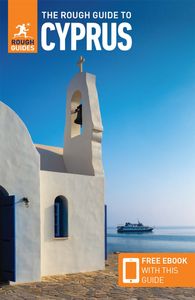
Find even more inspiration here

Planning your own trip? Prepare for your trip
Use Rough Guides' trusted partners for great rates

written by Andy Turner
updated 11.10.2023
Ready to travel and discover Cyprus?
Get support from our local experts for stress-free planning & worry-free travels.
- Where to stay
- Travel advice
- 1 Understand
- 2.1 By plane
- 3.1 On foot
- 3.3 By taxi
- 7.2 Mid-range
- 7.3 Splurge
- 9.2 Mid-range
- 9.3 Apartments
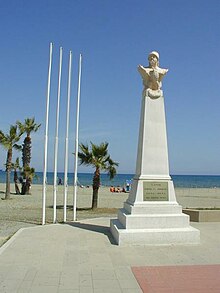
Larnaca [dead link] ( Greek Λάρνακα Larnaka ) is a city on the southern coast of Cyprus . With 85,000 citizens in 2015, metropolitan Larnaca is the island's third largest city.
Understand [ edit ]
Larnaca has a reasonable claim to being the oldest city in Cyprus , with evidence of habitation up to 6,000 years ago. Major landmarks are the Church of St. Lazarus, and the Hala Sultan Tekke.
Modern Larnaca, like other Cypriot coastal towns, is divided into an older city centre and a wide sprawl of hotels and restaurants along the beach.
Get in [ edit ]
By plane [ edit ].
Shared taxis ( dolmus ) connect Larnaca to Nicosia and Limassol .
Get around [ edit ]

On foot [ edit ]
Larnaca is a thin ribbon of a town and you can walk around most of it. The seaside Larnaca Promenade ( Phinikoudes ) is particularly pleasant for a stroll in the evening.
By bus [ edit ]
Bus fares (daytime) cost 2.40 cash or 1.80 with a pre-paid card.(updated April 2024) A card costs 5 euro and is valid for 10 years. It can be used for multiple passengers on the same journey.
The bus 425 goes from the airport to the town centre every 20 minutes during the day.
By taxi [ edit ]
By law, taxis should charge by the meter, but many cabbies will refuse to use it. Metered fares should be 65 cent; to get in plus 22 cent/km, night surcharges apply after midnight.
See [ edit ]
Do [ edit ].
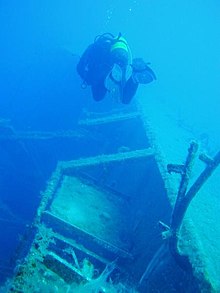
- Football: AEK Larnaca play soccer in the First Division, the top tier in Cyprus. Their home ground AEK Stadium (capacity 7400) is 2 km west of the city centre.
- Diving: the main reason to dive in Larnaca is the wreck of the Zenobia, a ro-ro ferry that sank in 1980 on her maiden voyage only a few hundred metres from the harbour due to a fault in the ballast computer. Fully laded with trucks and their cargo, the ship now lies on its side at a depth of 42 m, with the top of the wreck at 18 m and thus easily accessible even to PADI Advanced Open Water divers. If your flight comes in right, you can even see the shadow of the wreck as you land at Larnaca airport.
- @lpha Divers ( Alpha Divers ), 2, Pyla Gardens, Dhekelia Road ( next to Lordos Beach Hotel and Mariandy Hotel ), fax : +357 24-647519 . A PADI Five Star Gold Palm Instructor Development Centre and a British Sub-Aqua Club Premier & Technical Centre.
- Dive-In Cyprus , Blu View Residence, 132 Piale Pascha , ☏ +357 24-627469 . A PADI 5-star dive center and Regional SDI/TDI office that specializes in dives to the Zenobia, it can also arrange nitrox and penetration dives for the technical diver. Full range of PADI, TDI, TecRec and SDI courses available.
- Aquadream Scuba Diving Academy , Adonidos 13 ( directions ), ☏ +357 99397287 , +357 24103257 , [email protected] . Aquadream Scuba Diving Academy is a safe and friendly dive centre in Larnaca centre. Daily dives to the Larnaca wrecks and to the best dive sites on the island. ( updated Feb 2017 )
Buy [ edit ]
The nearby village of Lefkara is famous for its lace and silverware, and Larnaca being the nearest large town to the village, sells both in plentiful supply.
Independent jewellers and watchmakers are abundant, particularly among and just off the main Ermes/Ermou Street.
- Oro Fino Jewellery , Pavlou Valsamaki 26 ( 50 m from Foinikoudes beach, near St. Lazaurs ), ☏ +357 24-654666 . Italian and Greek designs, diamonds to zircons, precious to semi-precious stones. The shop features Newd Skin Jewel and brand watches like Guess, D&G and DKNY.
- 34.91568 33.6334 1 Academic & General Bookshop , Ermou 41 , ☏ +35724628401 . An excellent bookshop with a wide selection of English books
Eat [ edit ]
The beaches of Larnaca are littered with identikit seafood restaurants catering to tourists. The easiest way to find a good place is to simply walk along until you find a restaurant packed not with tourists, but with Cypriots!
Budget [ edit ]
Eating in Larnaca can be quite expensive. However, if you're travelling on a budget, there are a few bargains to be had. Possibly the cheapest way is by grabbing a hotdog at the 'Enjoy kiosk' on, you guessed it, Phinikoudes Avenue. Hotdogs are just €1 and rather enjoyable.
All these are in the city centre:
- 34.916682 33.63481 1 Edesma Cyprus Taverna - Souvlaki Place , Lordou Vyronos 50 . Amazing place. Authentic Cypriot taverna, great food, service, atmosphere. The specialties of the kitchen are seasoned with white wine and home-made zivania. Direct, friendly welcome. Delicious halumi, chicken, feta salads. The chef knows what he's doing. ( updated Jan 2023 )
- 34.917688 33.636222 2 Falafel Abu Dany , Akamia Center, Grigori Afxentiou 10 . Something divine. It doesn't compare to any other Lebanese restaurant. It's a small veggie place on the street, with three tables outside. Buda bowl, Faul, Falafel salad to be loved. Milos makes not only falafel but different kind of meals that are not only incredibly tasty but also healthy. ( updated Jan 2023 )
- 34.911339 33.636298 3 Souvlaki.gr , Pavlou Valsamaki . Want to feel real Grerk Cypriot cuisine? You have to visit that street bar. Delicious food and staff very friendly. Massive portions. Really good souvlaki wrapped in pita. Everything is fresh and super tasty. It's usually pretty crowdy there. ( updated Jan 2023 )
- 34.911173 33.63493 4 Za'atar Lebanese Bakery , Faneromenis 21 . This is a nice simple restaurant with some options on the menu. Everything is freshly made. The pizza and the falafel sandwich is delicious. Highly recommended if you fancy some Mediterranean food or a quick bite. The best freshly baked lahmajun. Delicious baked goods like baklava for around €3 (Nov 2022). Nice area to sit outside and under cover. ( updated Jan 2023 )
- 34.911647 33.636892 5 BIGBUN , Kleanthi Kalogera 39 . Very nice and cool place to grab a bite. Legit taste of burgers, they even have veggie ones. Crispy and golden fried potatoes were made from fresh potatoes. Interesting options. Very nice service. ( updated Jan 2023 )
- 34.914471 33.635764 6 Yummy India , 58, Zenonos Pierides Kiteos Street . Tasty and the amount of spices is perfect. Lots of options for both vegetarians and non-vegetarians. Chana Masala, Dhal Makhani and Mattar Paneer are amazing. The ambience is good. ( updated Jan 2023 )
Mid-range [ edit ]
- 34.907946 33.637501 7 Militzis , 42 Piale Pasha , ☏ +357 24 655867 . A long-running favorite serving honest Cypriot fare washed down with their own wine. No points for presentation, but the food is good and the restaurant is often packed. Figure on €15-20 (April 2018) for a meal. ( updated May 2022 )
- 34.914696 33.637333 8 Hobo's Steak House , Phinikoudes Promenade . A lively cafe/restaurant popular with many Cypriots, right on the main promenade. You can't miss it, and its often full but doesn't take telephone reservations. Food is varied from Cypriot to International Cuisine. ( updated May 2022 )
- 34.974689 33.679029 9 Vlachos Taverna . on the Dhekelia Rd, 400 m past the Palm Beach Hotel on the same side is a fantastic place to eat local food. Sheftalia is just great and the salads are lovely. ( updated May 2022 )
Splurge [ edit ]
- 34.915118 0 10 Nippon , Stadiou 120 , ☏ +357 24657555 . Expensive, but renowned Japanese restaurant serving sushi. Bookings are essential, as it is packed every night. Offers a wide range of delicious maki, California rolls and teppanyaki. ( updated Jan 2023 )
Drink [ edit ]
In the city centre an area just off the main promenade called "Laiki Yeitonia" fulfils the need for most Bars and Small scale Nightclubs. 34.914378 33.638002 1 Club Deep is the most popular of these, along with Times .
Driving about 15–20 minutes away from the City Centre to the east in the direction of Ayia Napa is the Larnaca-Dhekelia Road. This is the main 'strip' for high quality hotels, nightclubs, bars, etc., and is where most British Tourists can be found.
- 34.915723 33.62755 2 Blue Pine Bar , Louki Pieridi 3 , ☏ +357 24 646553 . Near the American Academy has a huge selection of spirits (all real which is unusual for Cyprus) and has a real atmosphere. The decor is wood and dim lighting and lots of Jack Daniels and Blues music paraphernalia. Comes alive after 22:00. By far the best bar in Laranaca for chilled music and spirits. ( updated Mar 2015 )
- 34.930051 33.602629 3 Caramel Club , 2 Agiou Spyridonos . 23:30-05:00 . Disco club. Music of all tastes from international Dj sets till morning and elegant dress code. Mixed Russian/Greek/Briton crowd ( updated Mar 2015 )
- 34.911986 33.637378 4 Savino , Watkins 9 , ☏ +35724620861 . Lively rock bar with many seats and often a good crowd. Live music on occasion. Shots cost around €5. ( updated Nov 2022 )
- 34.89863 33.63886 5 Nusa Beach Bar , Piale Pasa 11 , ☏ +35724646434 . Cocktail bar on Kastella beach with outdoor seating facing the sea. ( updated Feb 2024 )
Sleep [ edit ]
There are countless hotels and hotel apartments of varying degrees of luxury by the seaside.
- Frangiorgio Hotel Apartments . A modern hotel 1-minute walk from the town's main beach and shopping areas. It has 24 furnished apartments with equipped kitchens, air-conditioning systems, heating, satellite TVs, double glazed windows, private balconies and telephones. Other facilities include: daily cleaning of rooms, laundry service, bar, fax service, internet facilities, 24-hour reception and an in-house 24-hour mini market. Rates range from £16 to £40 depending on the season.
- [dead link] Sandbeach Castle Hotel , ☏ +357 24-655437 . Piale Pascha. A fairly typical 2-star hotel, a bit of a hike from the city centre, but not too far from the dive shops. Clean and generally acceptable. Rooms from £18.80 and up (with breakfast) in the low season, add in another £5 for the winter high season.
- 34.977364 33.691673 2 Golden Bay Beach Hotel , Dhekelia Rd ( take Highway to Ayia Napa from the airport, then teke Pyla Exit, turn on the first right, and then right again, then left when you reach the end of the road ), ☏ +357 24645444 . Check-in: 14:00 , check-out: 12:00 . Part of the Lordos Golden Hotels in Cyprus. 5-star hotel located near the town of Pyla, 10 km from central Larnaca.
Apartments [ edit ]
- Blue Serenity Private Villa . Pervolia 10 min in car . A brand new family villa - 3 bedrooms - fully air conditioned - private pool. Nice quite getaway place. Prices in low season from £400 per week, rising to £600 in the high season.
- 34.978419 33.688636 3 [dead link] Paschalis Hotel Apartments , 2 Olympou Street, Pyla ( Exit the airport directly onto the A3 motorway in the direction of “Ayia Napa”. Exit at junction 60 for “Pyla/Dhekelia”, at the end of the slip road turn right onto the B3 road and follow directions for Dhekelia. At the end of the road, at the lights, turn right onto Dhekelia Road. Continue for 1km along Dhekelia Road. Paschalis Hotel Apartments is on the right, just after the Golden Bay, Sandy Beach and Lordos hotels ), ☏ +357 24 64 52 22 . Check-in: 14:30 , check-out: 11:00 . About 200 m from the beach. 10 minutes by car from Larnaca town and 20 minutes from Larnaca International Airport. A family run complex offering 12 modest and spacious one-bedroom, self-catering apartments with equipped kitchen, bath or shower room, lounge/dining room and private balcony. All apartments are light and refreshing with open-plan living space totalling 50 m², sleeping up to four adults or families of up to five including children and/or infants. Private swimming pool or the local beach via an easily accessible path across from the apartments.
- Pyla Village & Pyla Palms & Pyla Gardens Resorts Apartments , Pyla ( take A1 from Airport to Ayia Napa come off at 2nd turn for Pyla Village, Pyla Palms on right 2 miles and Pyla Village Resort 0.5 miles on right ). Private apartments with pool, 10 km from Larnaca. 5 minutes drive from beach, and 8 to 12 minutes walk to Pyla town. from £119 pppw .
- [dead link] Sveltos Beach Apartments , Piale Pasha, Mckenzy ( Mckenzy Beach ), ☏ +357 246 57240 . Self-catering apartments 10 m from the sea with views over Larnaca Bay towards Cape Greco. Rates from €35 a night in low season for a one bed apartment sleeping two to €65 a night for a 2-bedroom apartment sleeping 4 in high season. €35 .
Go next [ edit ]
- Agia Triada
- Lefkara , a small, beautiful town, 30 km away.
- Has custom banner
- Articles with dead external links
- Has map markers
- Airport listing
- Has mapframe
- Do listing with no coordinates
- Buy listing with no coordinates
- Sleep listing with no coordinates
- Has Geo parameter
- Larnaca district
- All destination articles
- Usable cities
- Usable articles
- City articles
- Pages with maps
Navigation menu

5 Villages to Visit in the Limassol District
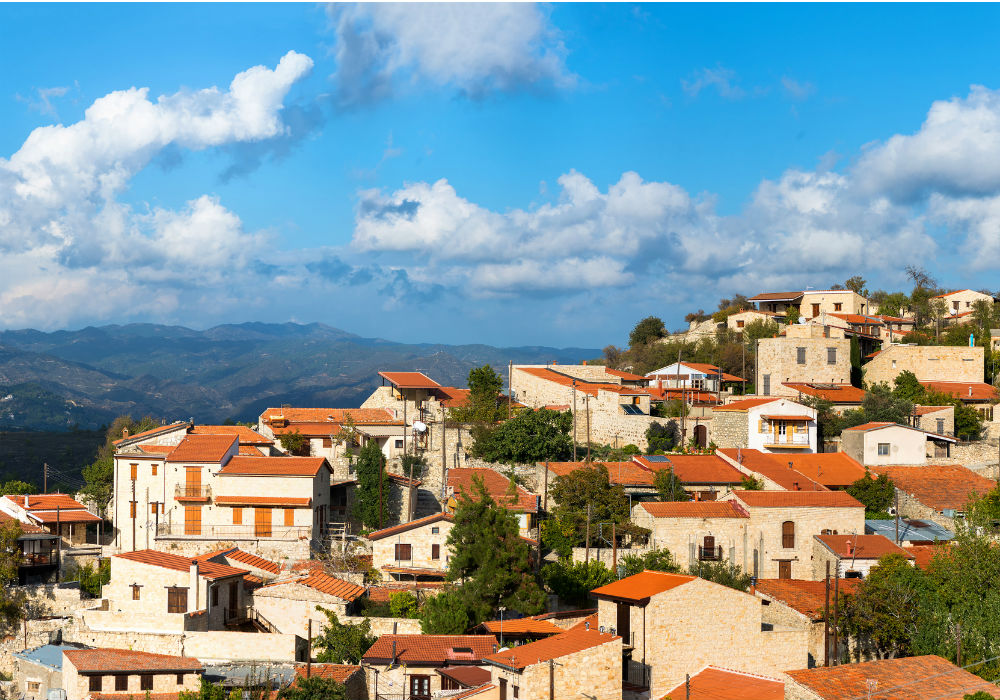
Need a break from the city or the packed beaches? Cyprus has numerous traditional villages scattered around just waiting to be discovered. From artistic corners and hectares of grapevines to unique local produce, these villages in the Limassol district provide delights whether you’re travelling solo, with a group of friends or with family. The villages are always a great place to try authentic Cypriot dishes, explore old architecture and indulge in a sweet conversation with the hospitable villagers; check out these ones that we think shouldn’t be missed.
This colourful village is known for its wine production. It is believed to have aptly gotten its name from Lana, the daughter of Dionysos, the God of wine. Apart from its wine and the world-famous commandaria , which you can try at the tavern, the village also produces olive oil with a traditional olive press that uses large circular stones. Today, the olive press is used to make soutzouko , but you can visit it to see how olive oil was extracted.
Another landmark worth a visit is the church in the centre of this tiny village which dates back to the seventeenth century. Also explore the Traditional House Museum and the Old Wine Press to see how things were done in the village in the old days.
During the peak of copper production in Cyprus around 1600 BCE, Lania became an important settlement for miners. During the last decade, the village has gone through a dramatic transition with an influx of British nationals and numerous artists who have renovated old houses and opened up art studios.
Taking a stroll along its alleys; you’ll spot colourful houses with bright plant pots and artists ready to show you their work. If you have a creative eye, Lania hides many photoworthy corners.
Lofou village, 26 kilometres northwest of Limassol, is built in a circular pattern on the hills as its name would suggest ( lofos is Greek for hill). Situated between mountain valleys, the landscape is divided by two rivers which both come from the River Kouris.
Yet another wine-making village Lofou offers beautiful panoramic views, and was converted into a stunning vineyard under British rule. One spot to catch particularly great views is the schoolyard, built in an open space overlooking the valley.
Explore the village on foot, as you’ll do with most Cypriot villages, and you’ll discover the beauty of the pebbly Lofou streets, where among the old houses and antiquity you’ll even find some fine street art . After your walk, you’ll probably want to rest your feet and fill your stomach. Lofou is known for its delicious tavern food and home-cooked dishes, so pick any spot and dive into the rich meze.
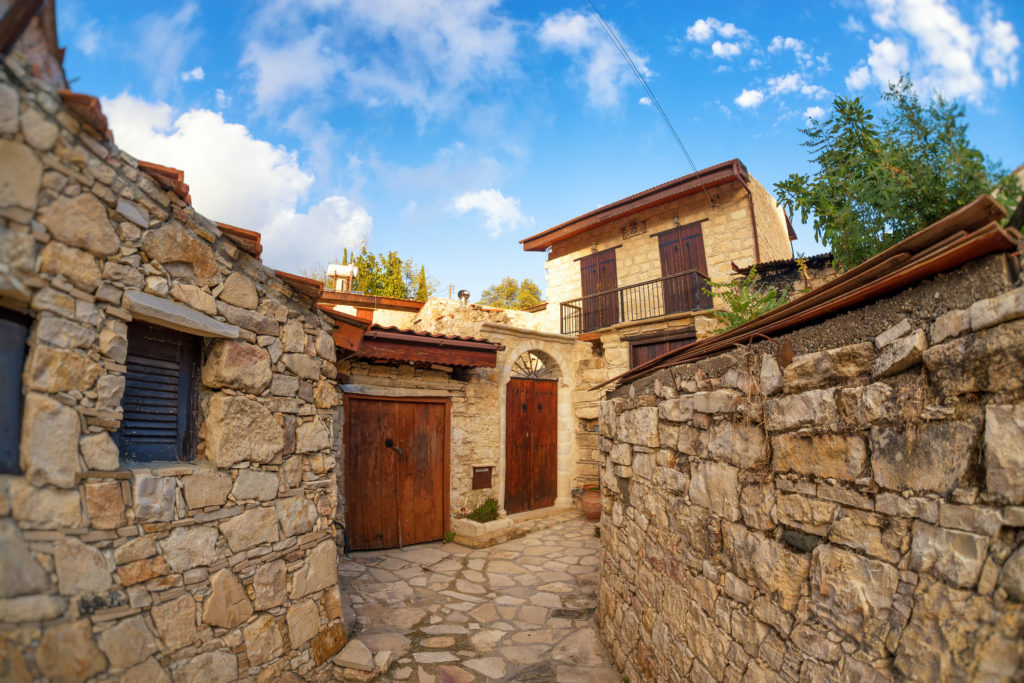
Street in the traditional Cypriot village Lofou. Limassol District, Cyprus
Tip: For a more immersive trip, visit during the Grape Fest in September, when the village celebrates its harvest, and watch how traditional delicacies are made from grape juice.
Omodos is possibly one of the most well-known villages of Cyprus because of its picturesque sites, its local products and its monastery. Found 42 kilometres north-west of Limassol, it is a wine-producing and agrotourism hotspot .
Famous for its wine and Zivania , it’s the place to taste local beverages accompanied by arkatena bread while browsing the lace embroidery made by the women of the village. With this variety of local products, Omodos offers unique souvenirs that are distinctive of Cyprus and its heritage. The most popular gifts are lace tablecloths and koulourka .
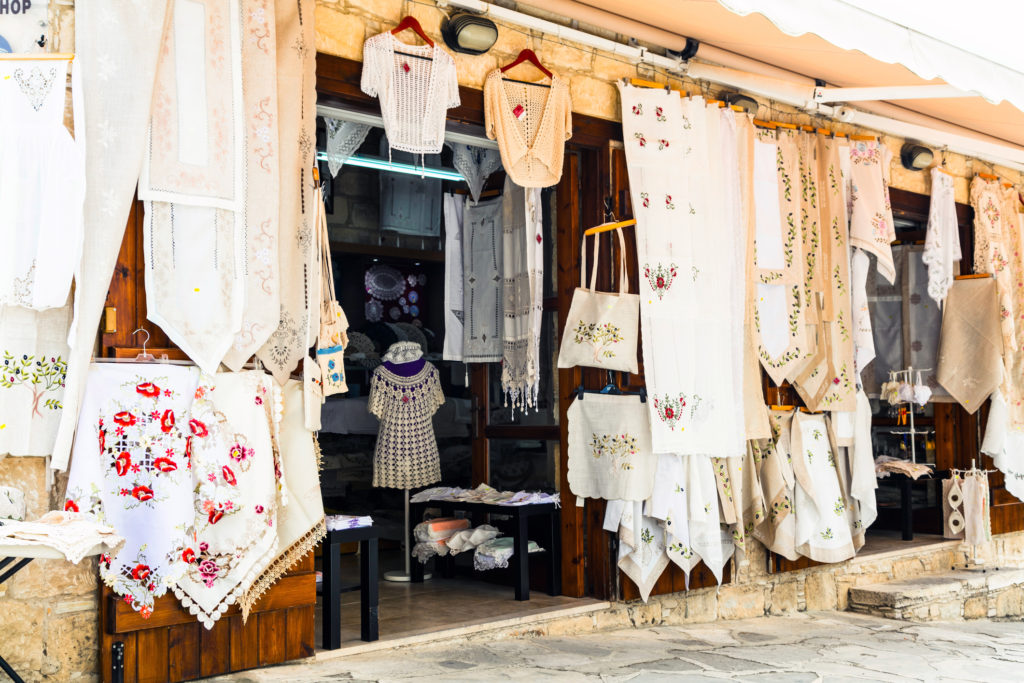
Lace floral tablecloths traditional to Omodos
The main street is filled with tavernas and shops and leads to the Holy Cross Monastery, an important site for the village and the island in general. Every September, Omodos holds one of the biggest religious fairs on the island, dedicated to the Holy Cross and lasting three days during which vendors gather in the beautiful square in front of the monastery to sell their goods. It’s a festivity that gathers many people and is a great chance to see the village at its liveliest.
Tip: Find out more about Omodos’ lace at the Omodos Centre for the Preservation of Lace .
Vasa Koilaniou
Found between the villages of Pera Pedi and Platres, this is the fifth vine village in Limassol (or krasoxori , as the Cypriots say). Its high-quality wine is known all over the island, so paying a visit to the village and tasting the fruit of its grapevines is a must. Also try its Zivania and soutziouko , palouze and kiofterka (sun-dried palouze).
Along the way, you can also enjoy the Museum of Education, the Museum of Zivania, the Ecclesiastical Museum, a winery, the main church of the village, the Bridge of Gerovrysi, and a small nature trail.
The houses are made of limestone, so architecture fans can observe the old structure of Cypriot houses.
As does Lofou, Vasa also holds a Grape Fest in September with grape juice products and folklore music, so if you’re on the island around that time of year, why not make a road trip out of it?
Agros is a relatively large village nestled between the mountains, giving it a cool climate that makes it a popular destination for Cypriots who want to escape the city heat.
The village is mostly known for its cultivation of roses and associated products like rosewater and rose oil. There’s an annual rose festival every May that welcomes hundreds of guests who venture up to buy rose and other traditional products.
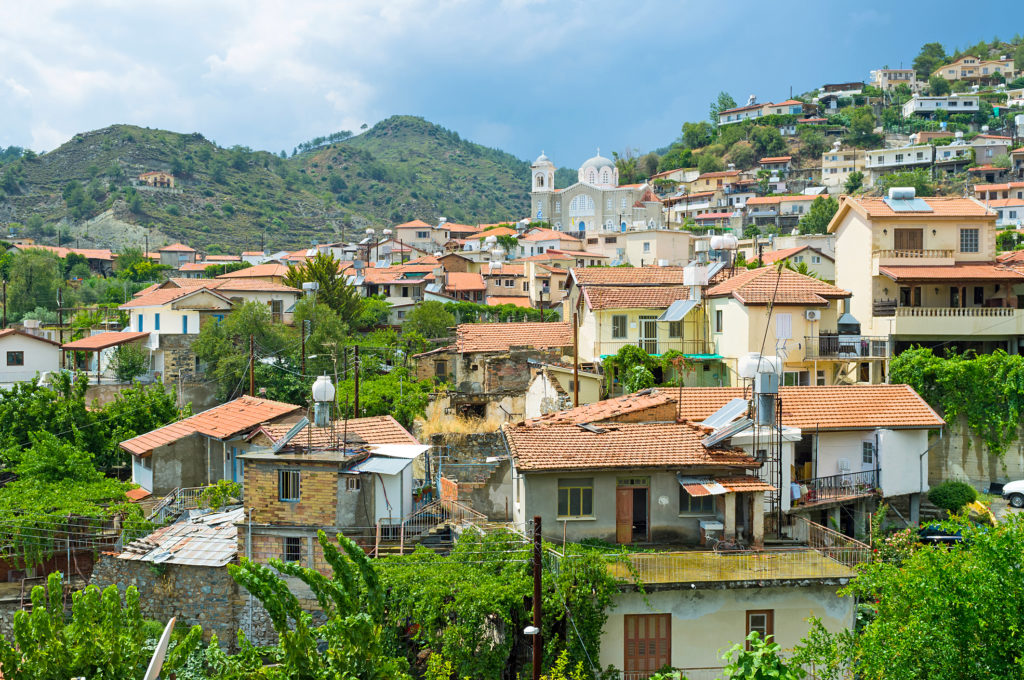
The Agros village located in Troodos district and boasts amazing views, Cyprus.
Its name derives from the forty monks who arrived in Cyprus from Asia Minor during the iconoclastic period, calling it after the place they had left behind: Megas Agros. They built a monastery at the spot where the Church of Panagia of Agros is found today.
With 800 inhabitants and many visitors, it’s a well-kept village with modern roads connecting to Nicosia, Limassol and Troodos. The villagers here are known to be hardworking and produce a lot of jams and spoon sweets , which you mustn’t miss out on tasting.
Related Posts
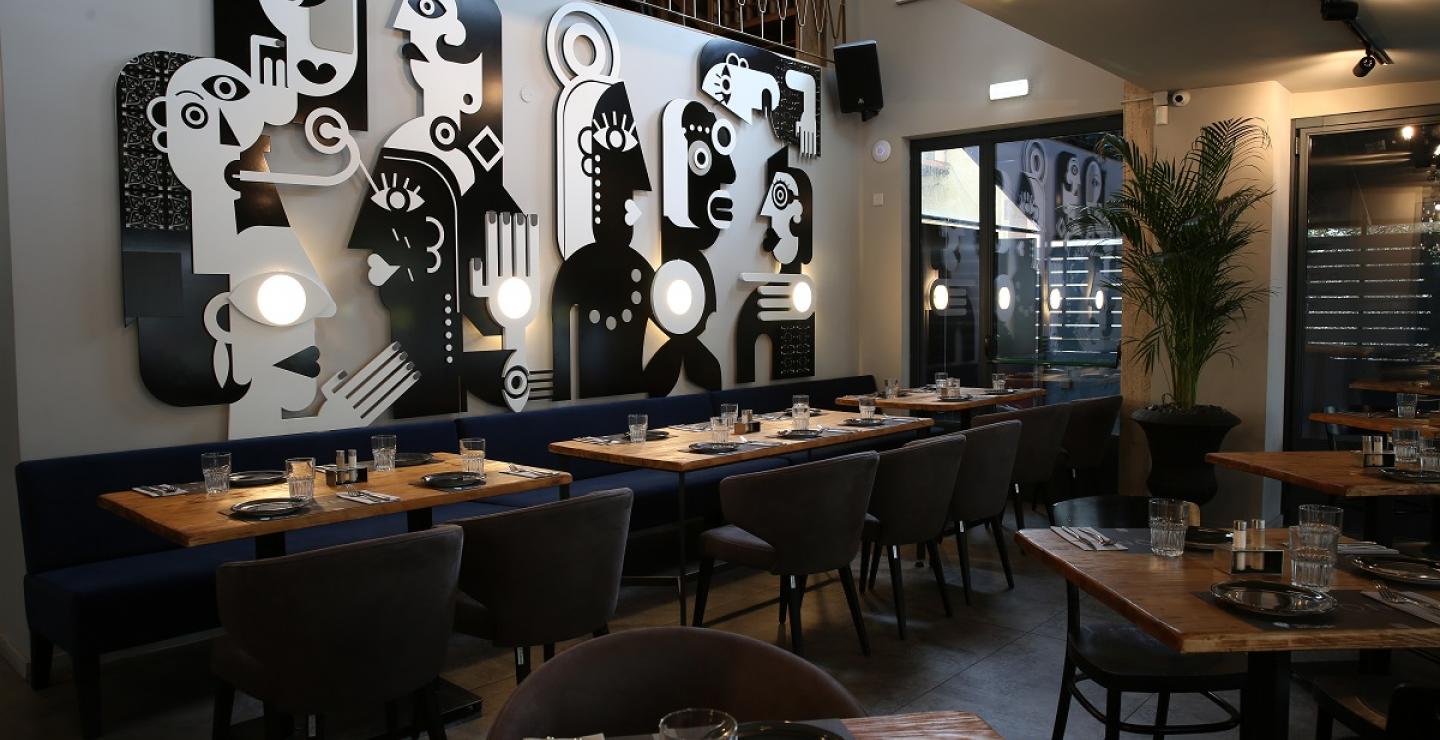
Try these 4 revamped restaurants
Three of Nicosia’s most beloved restaurants and one in Limassol…
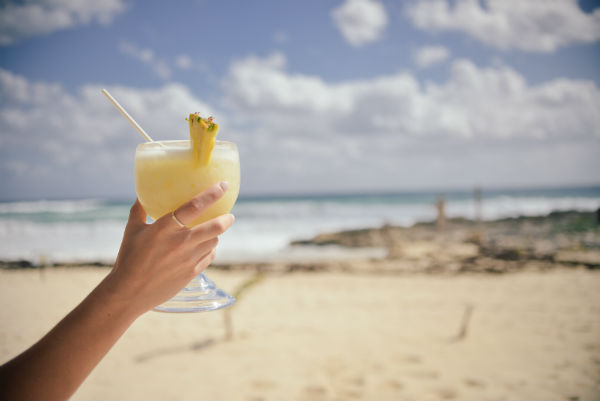
Soaking up the Sun at Cyprus’ 10 Best Beach Bars
Some of your summer’s memorable moments will no doubt be…
YOU MIGHT LIKE THIS
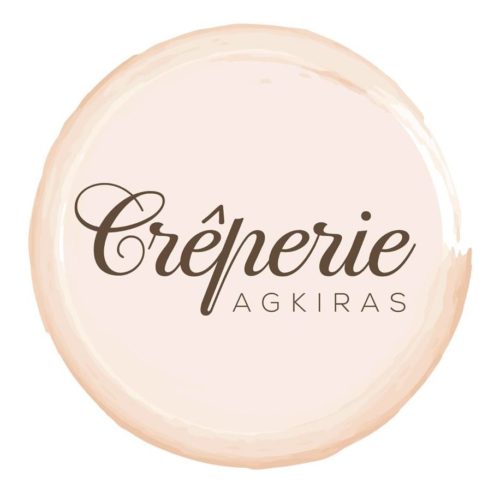
Creperie Agkiras
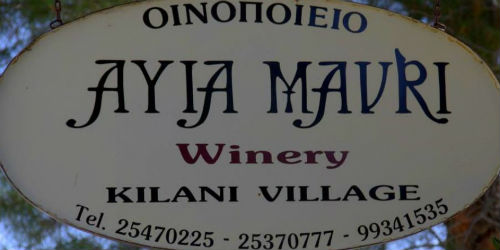
Ayia Mavri Winery
Things to do in cyprus.
- Walking-running-hiking in Cyprus
- Cycling in Cyprus
- Golf in Cyprus
- Camping in Cyprus
- Things To Do in Paphos
- Things To Do in Larnaca
- Things To Do in Limassol
- Things To Do in Nicosia
- Things To Do in Famagusta
- Things To Do in Troodos
Activities in Cyprus
- Activities in Paphos
- Activities in Larnaca
- Activities in Limassol
- Activities in Nicosia
- Activities in Famagusta
- Activities in Troodos
Cyprus Events
- Paphos Events
- Larnaca Events
- Limassol Events
- Nicosia Events
- Famagusta Events
Cyprus Museums
Cyprus attractions, cyprus sightseeing, bars in cyprus.
- Bars Paphos
- Bars Larnaca
- Bars Limassol
- Bars Nicosia
- Bars Famagusta
Nightlife in Cyprus
- Nightlife in Paphos
- Nightlife in Larnaca
- Nightlife in Limassol
- Nightlife in Nicosia
- Nightlife in Ayia Napa
- Nightlife in Troodos
Restaurants in Cyprus
- Restaurants in Paphos
- Restaurants in Larnaca
- Restaurants in Limassol
- Restaurants in Nicosia
- Restaurants in Ayia Napa
- Restaurants in Troodos
Hotels in Cyprus
- Hotels in Paphos
- Hotels in Larnaca
- Hotels in Limassol
- Hotels in Nicosia
- Hotels in Ayia Napa
- Hotels in Troodos
Agrotourism in Cyprus
Shopping in cyprus.
- Shopping in Paphos
- Shopping in Larnaca
- Shopping in Limassol
- Shopping in Nicosia
- Shopping in Ayia Napa
- Shopping in Troodos
Cyprus Weddings
Moving to cyprus.

IMAGES
VIDEO
COMMENTS
Exploring Larnaca's Rural Villages. Larnaca isn't just about its popular palm tree promenade and its numerous beaches. A short ten-minute drive out of town can take you to some of the region's most important and beautiful rural villages and surroundings, the exploration of which promises days of discovering the island's history, culture and national heritage.
10. 11. Map courtesy of Wanderlog, an itinerary planner on iOS and Android. 1. Pedoulas Village, Nicosia. Pretty Pedoulas Village. One of the best Troodos villages to visit, picturesque P edoulas is located in the Nicosia district of Cyprus. High in the Troodos Mountains, it has a distinctly alpine feel to it.
Kato Drys. Lefkara's neighbour Kato Drys is equally picturesque and is one of the nine 'Rural Larnaka Honey Villages'. Visit the unusual and unique Bee & Embroidery Museum; the traditional 'Local Agricultural Museum of Kato Drys', or enjoy some more wine tasting at Ktima Christoudia where you will be guided on the traditions of wine making and can sample the delicious local wines ...
Spot the flamingos at Larnaca Salt Lake. 7. Enjoy the traditional local life in Perivolia. 8. Visit an active wind farm. 9. Snap a pic at Perivolia Lighthouse. 10. Dive into the history at the archaeological site of Kition.
The villages surrounding Larnaca are some of the best places to visit if you want to get a feel for traditional Cypriot life. Famous for its lace production, the village of Lefkara, west of Larnaca, is a delightful place to explore, full of wonderfully preserved mansion architecture, quaint cafés, and a bundle of lace shops where local women ...
Larnaca boasts golden sand beaches, interesting history, and an excellent location for exploring the rest of Cyprus. Table of Contents. Best Things To Do in Larnaca. 1. Spend the Day at Finikoudes Beach. 2. Take a Troodos Mountain Wine Tasting Tour. 3. Cycle the Larnaca Salt Lake.
In this article, we delve into 10 of the most scenic villages to visit in Cyprus. Ranging from traditional mountain settlements to charming coastal towns, these locales offer a deep dive into the rural lifestyle of Cyprus and highlight the island's natural splendour. ... Kato Drys is a traditional mountain village located in the Larnaca ...
5. Kiti. The large village of Kiti is located very close to Larnaca Airport. It is known for maintaining its historical appearance and Cypriot charm despite its modernity and development. The first thing to visit in Kiti (besides the local streets, of course) is the church of Panagia Angeloktisti.
Villages. Larnaca Villages. Larnaca is a district in the southeast coast of Cyprus. It is the successor town of ancient Kition one of the most important kingdoms in ancient Cyprus. It is also the birthplace of the well-known ancient philosopher Zinona. The Larnaca district is one of the 6 districts in Cyprus and is the fifth largest on the island.
Away from the tourist areas, the Larnaca countryside has a diverse wealth of its own with traditional villages, narrow streets tiny churches, remote monasteries and scenic views. The villages surrounding Larnaca town are endowed with historical, natural and cultural riches. These traditional settings enhance and complement a wonderful natural ...
Larnaca Travel Cards: 1, 2, or 7-day travel cards to travel across Larnaca city, from urban to rural or airport zones, with unlimited access to modern bus lines. ... Situated a few kilometers outside Larnaca, Pervolia is a peaceful village with a more relaxed atmosphere. It has several beachfront resorts and holiday homes, making it an ideal ...
With more than 24 hours in Larnaca, you can either take it easy at the beach and bars or explore more of Cyprus. In case the latter sounds more appealing, here are a few nice places to visit that are easily accessible from Larnaca. 1. Nicosia. The most obvious place to visit from Larnaca is the divided capital city of Nicosia.
By paraphernalia-co. Now a museum, three rooms are dedicated to preserving the fort's history and origin. See ways to experience (5) 10. Kyriazis Medical Museum. 71. Speciality Museums. This is one of the few museums in the world where the visitor can touch and explore old medical instruments without restrictions.
Pottery Workshop. See full details. 7. The House of Platini. 54. Speciality Museums. The museum is dedicated to the French former soccer great and former UEFA president Michel Platini. A huge collection of sporting exhibits: 40. 669 items. Two entries in Guinness World Records.
Visiting a village for a look into traditional life in Cyprus is a must when visiting the country. The most popular village to see crafts like lace and silver making is Lefkara, as it's just a 40-minute drive from Larnaca. Lefkara village was adorable and had hints of the villages and towns I've been to in Italy: small streets, flowers hanging all around, and cafes around a central square.
The Larnaca district is one of the 6 districts in Cyprus and is the fifth largest on the island. It has an extent of 1120 square kilometres. Larnaca is then divided into 6 municipalities and 53 communities/villages. The municipalities are: Aradippou, Athienou, Drimolaxia - Meneou, Larnaca, Livadia and Pano Lefkara.A list with all the communities/villages of Larnaca can be found on the table ...
Larnaka. East meets west in the ancient district of Larnaka (Larnaca), where hundreds of years of contrasting civilizations, architecture and culture have left their mark on an authentic and diverse region. Both Christianity and Islam have important religious sites in Larnaka. The Church of Saint Lazarus, who lived in Larnaka after his ...
This site is owned by Apa Digital AG, Bahnhofplatz 6, 8854 Siebnen, Switzerland. Rough Guides® is a trademark owned by Apa Group with its headquarters at 7 Bell Yard London WC2A 2JR, United Kingdom. Larnaka and around - plan your visit with Rough Guides and get travel tips, recommendations and advice for where to go and what to do.
10. Kyriazis Medical Museum. This is one of the few museums in the world where the visitor can touch and explore old medical instruments without restrictions. The visitor can experience how medicine was practiced in the old times, and also explore magic, incantations, medical words and many other aspects of medicine.
8. Walk around Larnaca Marina. Source: Pixabay. This is a very relaxing place where you can go for just a nice walk along the sea while enjoying a sunny day, or, you can also book a boat or a diving trip to explore the famous wreck site in Larnaca. They are both good ideas.
Larnaca has a reasonable claim to being the oldest city in Cyprus, with evidence of habitation up to 6,000 years ago. Major landmarks are the Church of St. Lazarus, and the Hala Sultan Tekke. Modern Larnaca, like other Cypriot coastal towns, is divided into an older city centre and a wide sprawl of hotels and restaurants along the beach.
The real sea front promenade full of shops, restaurants, bars and hotels. 3. Zenobia Wreck. The best wreck in the world with best instructors, we will keep you safe on a magical mystery tour of this epic wreck that sank on the 7th June 1980 with 104 articulated lorries still fully laden with cargo on board.
Found between the villages of Pera Pedi and Platres, this is the fifth vine village in Limassol (or krasoxori, as the Cypriots say). Its high-quality wine is known all over the island, so paying a visit to the village and tasting the fruit of its grapevines is a must. Also try its Zivania and soutziouko, palouze and kiofterka (sun-dried palouze).